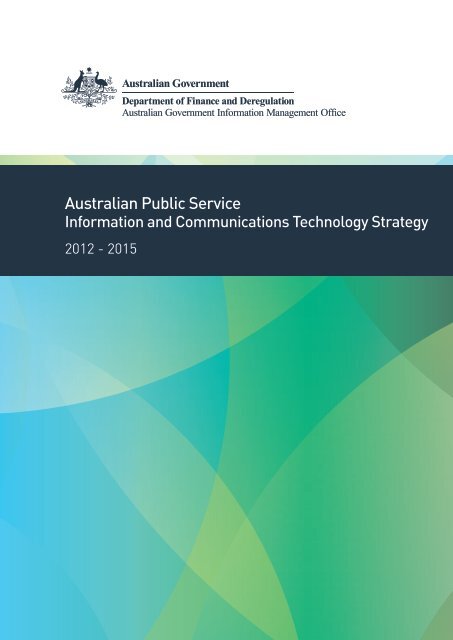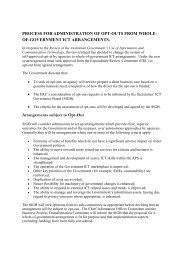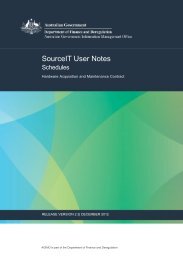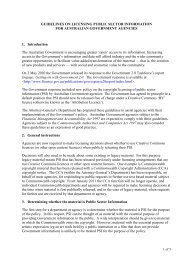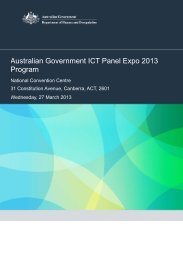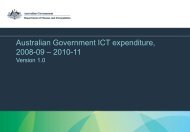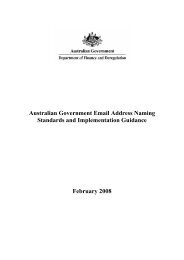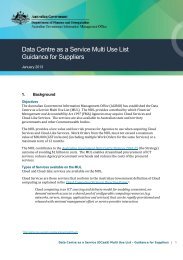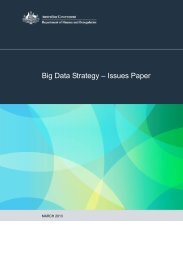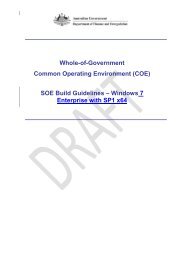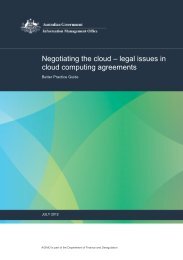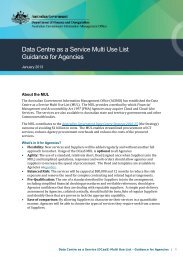APS ICT Strategy 2012 - Australian Government Information and ...
APS ICT Strategy 2012 - Australian Government Information and ...
APS ICT Strategy 2012 - Australian Government Information and ...
Create successful ePaper yourself
Turn your PDF publications into a flip-book with our unique Google optimized e-Paper software.
<strong>Australian</strong> Public Service<br />
<strong>Information</strong> <strong>and</strong> Communications Technology <strong>Strategy</strong><br />
<strong>2012</strong> - 2015
ISBN 978-1-922096-17-3<br />
Creative Commons<br />
With the exception of the Commonwealth Coat of Arms <strong>and</strong> where otherwise noted, this document is licensed under a<br />
Creative Commons Attribution 3.0 Australia licence.<br />
Apart from any use permitted under the Copyright Act 1968, <strong>and</strong> the rights explicitly granted below, all rights are<br />
reserved.<br />
You are free to copy, distribute <strong>and</strong> transmit the work as long as you attribute the authors. You may not use this work for<br />
commercial purposes.<br />
You may not alter, transform, or build upon this work.<br />
Except where otherwise noted, any reference to, reuse or distribution of all or part of this report must include the<br />
following attribution:<br />
<strong>Australian</strong> Public Service <strong>Information</strong> <strong>and</strong> Communications Technology <strong>Strategy</strong> <strong>2012</strong>-2015, Copyright <strong>Australian</strong><br />
<strong>Government</strong> <strong>2012</strong>.<br />
Licence: This document is licensed under a Creative Commons Attribution Non-Commercial No Derivs 3.0 licence.<br />
Use of the Coat of Arms<br />
The terms under which the Coat of Arms can be used are detailed on the It’s an Honour website.<br />
Inquiries regarding the licence <strong>and</strong> any use of the document are welcome at:<br />
Assistant Secretary<br />
Governance <strong>and</strong> Policy Branch<br />
<strong>Australian</strong> <strong>Government</strong> <strong>Information</strong> Management Office<br />
Department of Finance <strong>and</strong> Deregulation<br />
John Gorton Building<br />
King Edward Terrace Parkes ACT 2600<br />
Email: agimo@finance.gov.au
Contents<br />
Secretary’s foreword.....................................................................................................................4<br />
Executive summary.......................................................................................................................5<br />
The <strong>Strategy</strong>.........................................................................................................................................5<br />
Priority areas.......................................................................................................................................6<br />
Implementation...................................................................................................................................7<br />
Why we need an <strong>ICT</strong> strategy........................................................................................................8<br />
What this strategy addresses............................................................................................................8<br />
Delivering on expectations.................................................................................................................9<br />
Driving productivity.............................................................................................................................9<br />
Recent developments in the <strong>Government</strong>’s use <strong>and</strong> management of <strong>ICT</strong>...................................11<br />
Emerging opportunities—a platform for transformation..............................................................12<br />
The <strong>Strategy</strong>...................................................................................................................................14<br />
Achieving this strategy........................................................................................................................14<br />
1. Deliver better services..............................................................................................................15<br />
What the future looks like..................................................................................................................15<br />
How we know we have succeeded....................................................................................................15<br />
Strategic action one: Building capability..........................................................................................16<br />
Strategic action two: Improving services.........................................................................................17<br />
2. Improve the efficiency of government operations...................................................................19<br />
What the future looks like..................................................................................................................19<br />
How we know we have succeeded....................................................................................................19<br />
Strategic action three: Investing optimally.......................................................................................20<br />
Strategic action four: Encouraging innovation................................................................................21<br />
3. Engage openly............................................................................................................................24<br />
What the future looks like..................................................................................................................24<br />
How we know we have succeeded....................................................................................................24<br />
Strategic action five: Creating knowledge........................................................................................25<br />
Strategic action six: Collaborating effectively..................................................................................26<br />
Implementation governance.........................................................................................................28<br />
Timeframe...........................................................................................................................................28<br />
Governance..........................................................................................................................................28<br />
Agencies...............................................................................................................................................29<br />
<strong>Australian</strong> <strong>Government</strong> <strong>Information</strong> Management Office.............................................................29<br />
The implementation plan..............................................................................................................31<br />
Success indicators <strong>2012</strong>-2015......................................................................................................37<br />
Endnotes........................................................................................................................................40<br />
<strong>Australian</strong> Public Service <strong>Information</strong> <strong>and</strong> Communications Technology <strong>Strategy</strong> <strong>2012</strong>-2015 3
Secretary’s foreword<br />
As Chair of the Secretaries’ <strong>ICT</strong> Governance Board (SIGB), <strong>and</strong> as part of SIGB’s role to set<br />
whole-of-<strong>Government</strong> strategies on the use of <strong>Information</strong> <strong>and</strong> Communications Technology<br />
(<strong>ICT</strong>) across the <strong>Australian</strong> Public Service (<strong>APS</strong>), I have pleasure in releasing the <strong>Australian</strong><br />
Public Service <strong>Information</strong> <strong>and</strong> Communications Technology <strong>Strategy</strong> <strong>2012</strong>-2015 (the <strong>Strategy</strong>).<br />
<strong>ICT</strong> plays a critical role in delivering <strong>and</strong> transforming the operations of government.<br />
This <strong>Strategy</strong> outlines the benefits that we expect will arise from a strategic <strong>and</strong> coordinated<br />
approach to developing <strong>and</strong> using <strong>ICT</strong>. It positions the <strong>APS</strong> to respond to rapid technological<br />
change.<br />
The priorities <strong>and</strong> actions identified in the <strong>Strategy</strong> will position the <strong>Australian</strong> <strong>Government</strong> to<br />
use <strong>ICT</strong> in new, creative <strong>and</strong> innovative ways to deliver better, easier to use services in ways that<br />
best meet people’s needs <strong>and</strong> expectations.<br />
The <strong>Strategy</strong> outlines how <strong>APS</strong> agencies will continue to use <strong>ICT</strong> to drive better service delivery,<br />
improve government operations, drive productivity, <strong>and</strong> to engage with people, the community<br />
<strong>and</strong> business. It supports better, more accessible government services for people when, where <strong>and</strong><br />
how it suits them, so they can be more productive.<br />
In developing <strong>and</strong> implementing this <strong>Strategy</strong> it is my intention to maintain <strong>and</strong> enhance the<br />
<strong>Australian</strong> <strong>Government</strong> as a world leader in the use of <strong>ICT</strong>.<br />
The SIGB will review the <strong>Strategy</strong> on a regular basis to ensure that it remains relevant to<br />
<strong>Government</strong> priorities <strong>and</strong> to the opportunities provided by advances in <strong>ICT</strong>.<br />
David Tune PSM<br />
Secretary<br />
Department of Finance <strong>and</strong> Deregulation<br />
4<br />
<strong>Australian</strong> Public Service <strong>Information</strong> <strong>and</strong> Communications Technology <strong>Strategy</strong> <strong>2012</strong>-2015
Executive summary<br />
<strong>ICT</strong> has profoundly changed almost all aspects of society. It is now central to how people<br />
communicate, interact, make decisions <strong>and</strong> do business. This includes the way governments<br />
operate <strong>and</strong> deliver services.<br />
<strong>ICT</strong> plays a key role in social <strong>and</strong> economic transformation. It makes possible the transformation<br />
of government services, its business operations <strong>and</strong> enables open engagement with communities.<br />
Possibilities created by current <strong>and</strong> emerging technologies have also influenced <strong>and</strong> raised our<br />
expectations for dealing with government.<br />
The <strong>Strategy</strong> sets the direction for the use of <strong>ICT</strong> into the future. It identifies how we will realise<br />
the future we aspire to in 2015 – excellent delivery of government services to people <strong>and</strong> more<br />
efficient government operations that will enhance productivity in government <strong>and</strong> more widely<br />
through using the National Broadb<strong>and</strong> Network (NBN) <strong>and</strong> other information technologies.<br />
The <strong>Strategy</strong><br />
The <strong>Strategy</strong> statement is:<br />
“The <strong>APS</strong> will use <strong>ICT</strong> to increase public sector <strong>and</strong> national productivity by<br />
enabling the delivery of better government services for the <strong>Australian</strong> people,<br />
communities <strong>and</strong> business, improving the efficiency of <strong>APS</strong> operations <strong>and</strong><br />
supporting open engagement to better inform decisions.”<br />
The <strong>Strategy</strong> is built on a vision that our interactions with people, businesses <strong>and</strong> the community<br />
will occur seamlessly as part of everyday life. People will easily access <strong>and</strong> automatically receive a<br />
range of services streamlined from across government <strong>and</strong> tailored to their individual needs <strong>and</strong><br />
preferences.<br />
Decisions will be better informed through truly open, interactive government to support<br />
sustainable, vibrant communities.<br />
Individuals, communities, business, not-for-profits <strong>and</strong> the <strong>APS</strong> will collaborate more closely<br />
with all actively involved in the conversation <strong>and</strong> in co-designing innovative <strong>and</strong> location-aware<br />
government policies <strong>and</strong> services.<br />
Efficient government operations deliver more integrated, responsive <strong>and</strong> targeted information <strong>and</strong><br />
services.<br />
Individuals, communities <strong>and</strong> business spend less time <strong>and</strong> effort interacting with government,<br />
freeing up their time <strong>and</strong> resources for more productive activities.<br />
Mobile devices <strong>and</strong> other new technologies offer people new ways to be more productive<br />
personally. Equally, through new applications <strong>and</strong> technology solutions that match their needs,<br />
business has opportunities to drive <strong>and</strong> increase organisational productivity.<br />
<strong>Australian</strong> Public Service <strong>Information</strong> <strong>and</strong> Communications Technology <strong>Strategy</strong> <strong>2012</strong>-2015 5
Executive summary<br />
The global connectedness arising from technology creates opportunities for Australia’s<br />
participation in new economies, to be a leader in exploiting technology for national growth<br />
through the NBN <strong>and</strong> to be a preferred destination for new enterprises.<br />
The <strong>Strategy</strong> identifies actions to be taken between <strong>2012</strong> <strong>and</strong> 2015 to continue the release of<br />
government data for wider use, to share information <strong>and</strong> knowledge resources <strong>and</strong> unlock further<br />
economic <strong>and</strong> social value.<br />
Priority areas<br />
To increase productivity, the <strong>Strategy</strong> identifies strategic actions in three priority areas. These are:<br />
1. Deliver better services—more effective use of <strong>ICT</strong> delivers improved productivity <strong>and</strong><br />
streamlined, high quality government services that are personalised, easy-to-use <strong>and</strong> can be<br />
linked to other services. To realise this outcome we are:<br />
. building capability—improving <strong>ICT</strong> knowledge, skills <strong>and</strong> capacity across the <strong>APS</strong> to<br />
deliver more efficient, effective <strong>and</strong> improved services<br />
. improving services—using <strong>ICT</strong> to simplify <strong>and</strong> join together services that government<br />
provides to individuals <strong>and</strong> businesses, while ensuring security <strong>and</strong> privacy.<br />
2. Improve the efficiency of government operations—more innovative <strong>and</strong> strategic use of <strong>ICT</strong><br />
ensures greater value <strong>and</strong> more effective policy delivery that takes advantage of technologyenabled<br />
opportunities. To realise this outcome we are:<br />
. investing optimally—targeting <strong>and</strong> coordinating <strong>ICT</strong> investment <strong>and</strong> sharing resources<br />
<strong>and</strong> services to deliver the greatest value <strong>and</strong> improve efficiency <strong>and</strong> effectiveness<br />
. encouraging innovation—harnessing the full potential of the digital economy <strong>and</strong><br />
new technologies to promote innovative ideas <strong>and</strong> take-up of technology-enabled<br />
improvements.<br />
3. Engage openly—more active involvement of all stakeholders builds knowledge, sparks ideas<br />
<strong>and</strong> growth, <strong>and</strong> better informs decisions <strong>and</strong> solutions that meet local needs. To realise this<br />
outcome we are:<br />
. creating knowledge—generating, sharing, managing <strong>and</strong> more effectively using<br />
information to improve decision-making, drive economic growth <strong>and</strong> tailor services <strong>and</strong><br />
policies to local needs<br />
. collaborating effectively—strengthening networks, creating partnerships <strong>and</strong> using<br />
a variety of technologies to involve the wider community in developing policy <strong>and</strong><br />
informing service delivery.<br />
6<br />
<strong>Australian</strong> Public Service <strong>Information</strong> <strong>and</strong> Communications Technology <strong>Strategy</strong> <strong>2012</strong>-2015
Executive summary<br />
Implementation<br />
The following diagram depicts the strategic actions <strong>and</strong> projects within the three priority areas of<br />
the <strong>Strategy</strong>.<br />
Increased Public Sector <strong>and</strong> National Productivity<br />
DELIVER BETTER SERVICES<br />
IMPROVE THE EFFICIENCY OF<br />
GOVERNMENT OPERATIONS<br />
ENGAGE OPENLY<br />
Building<br />
capability<br />
Improving<br />
services<br />
Investing<br />
optimally<br />
Encouraging<br />
innovation<br />
Creating<br />
knowledge<br />
Collaborating<br />
effectively<br />
Improve use<br />
of existing<br />
technology<br />
capability<br />
Integrate<br />
technology<br />
with policy<br />
development<br />
<strong>and</strong> delivery<br />
Improve<br />
government<br />
program<br />
delivery<br />
capability<br />
Develop <strong>ICT</strong><br />
workforce<br />
skills<br />
Deliver simple<br />
<strong>and</strong> easy to<br />
use online<br />
services<br />
Deliver more<br />
personalised<br />
services<br />
Simplify<br />
government<br />
websites<br />
Increase the<br />
automation of<br />
services<br />
Improve<br />
investment<br />
governance <strong>and</strong><br />
information<br />
Ensure wholeof-government<br />
<strong>ICT</strong> investment<br />
Extend<br />
coordinated <strong>ICT</strong><br />
procurement<br />
Share<br />
computing<br />
resources <strong>and</strong><br />
services<br />
Open up <strong>ICT</strong><br />
development to<br />
foster innovation<br />
Deliver new<br />
<strong>and</strong> better <strong>ICT</strong><br />
enabled services<br />
Increase<br />
awareness <strong>and</strong><br />
early take-up of<br />
new <strong>ICT</strong><br />
Examine <strong>and</strong><br />
adopt new<br />
<strong>and</strong> emerging<br />
technologies<br />
more rapidly<br />
Build business<br />
intelligence<br />
Use location<br />
–aware<br />
information<br />
Develop tools<br />
<strong>and</strong> platforms<br />
to analyse data<br />
Release<br />
public sector<br />
information<br />
Strengthen<br />
external<br />
collaboration<br />
networks<br />
Build<br />
collaboration<br />
capability across<br />
government<br />
Build the<br />
channels needed<br />
for government to<br />
collaborate<br />
<strong>Australian</strong> Public Service <strong>Information</strong> <strong>and</strong> Communications Technology <strong>Strategy</strong> <strong>2012</strong>-2015 7
Why we need an <strong>ICT</strong> strategy<br />
<strong>ICT</strong> has radically changed many aspects of society over the past 40 years. It is now an integral<br />
part of everyday life. We are more connected, more often <strong>and</strong> from more locations. Vast amounts<br />
of information <strong>and</strong> diverse opinions are literally at our fingertips. People rely on a range of<br />
technologies to communicate, interact, inform decisions, <strong>and</strong> to provide <strong>and</strong> receive services <strong>and</strong><br />
products.<br />
Technological developments have increased personal, business <strong>and</strong> national productivity. <strong>ICT</strong><br />
has also become fundamental to how the government operates. <strong>Government</strong> use of <strong>ICT</strong> affects<br />
all <strong>Australian</strong>s. People <strong>and</strong> businesses benefit from simpler, easier-to-use <strong>and</strong> quicker interactions<br />
with government. The use of <strong>ICT</strong>-related opportunities is integral to developing government<br />
policies <strong>and</strong> services. <strong>ICT</strong> offers new ways to design, develop <strong>and</strong> deliver services, automate<br />
existing services, <strong>and</strong> more effectively consult <strong>and</strong> engage with a broader range of stakeholders.<br />
Ongoing <strong>and</strong> rapid changes in the technology l<strong>and</strong>scape include increasing business use of<br />
technology originally developed for personal use. Other developments include the unparalleled<br />
spread <strong>and</strong> influence of social media <strong>and</strong> the increased use of mobile services, broadb<strong>and</strong> <strong>and</strong><br />
cloud computing. Such changes can profoundly influence government <strong>and</strong> industry choices about<br />
investing in <strong>ICT</strong> <strong>and</strong> delivering government services.<br />
The <strong>Strategy</strong> provides an implementation plan for the future to guide service delivery strategies,<br />
<strong>ICT</strong> investment for government <strong>and</strong> contributes to efficient government operations.<br />
What this strategy addresses<br />
The <strong>Strategy</strong> outlines how the <strong>APS</strong> will use <strong>ICT</strong> to transform their operations <strong>and</strong> services to<br />
achieve policy objectives.<br />
To date, government use of <strong>ICT</strong> has been largely agency-focused. The recent <strong>ICT</strong> Reform Program<br />
<strong>and</strong> coordinated <strong>ICT</strong> procurement arrangements have improved integration, cooperation<br />
<strong>and</strong> transparency. Now it is time to take the next step towards greater productivity <strong>and</strong> more<br />
streamlined interaction within the <strong>APS</strong> <strong>and</strong> between government, people <strong>and</strong> business1.<br />
More visibility of <strong>ICT</strong> design <strong>and</strong> investment intentions between <strong>APS</strong> agencies is desirable.<br />
Decisions to acquire or upgrade <strong>ICT</strong> systems should consider the broader implications for<br />
services to people, business <strong>and</strong> the <strong>APS</strong>.<br />
This <strong>Strategy</strong> supports the <strong>Government</strong>’s broader policy objectives <strong>and</strong> major programs of work,<br />
including focusing on productivity growth, use of the NBN, the National Digital Economy<br />
<strong>Strategy</strong>, Service Delivery Reform, environmental sustainability, health <strong>and</strong> education reform, <strong>and</strong><br />
<strong>APS</strong> Reform.<br />
8<br />
<strong>Australian</strong> Public Service <strong>Information</strong> <strong>and</strong> Communications Technology <strong>Strategy</strong> <strong>2012</strong>-2015
Why we need an <strong>ICT</strong> strategy<br />
The <strong>Strategy</strong> refocuses the <strong>Government</strong>’s <strong>ICT</strong> priority to improving productivity. Productivity is<br />
about achieving outcomes in new or better ways. It is also about simplifying or ceasing processes<br />
that are inefficient. Reducing the compliance burden, the time it takes people, communities<br />
<strong>and</strong> business to interact with government, frees up time for us all to contribute to other, more<br />
productive activities. This ultimately leads to broader economic growth.<br />
The <strong>Strategy</strong> outlines a future where interaction with government will occur seamlessly as part<br />
of people’s everyday lives, where people <strong>and</strong> communities are connected <strong>and</strong> engaged to provide<br />
input to government policies <strong>and</strong> services, <strong>and</strong> where efficient government operations deliver<br />
faster <strong>and</strong> more targeted services.<br />
The <strong>APS</strong> will deliver this strategy <strong>and</strong> increase productivity of the public sector <strong>and</strong> the nation<br />
through strategic actions in three priority areas: to deliver better services to people, communities<br />
<strong>and</strong> business; improve the efficiency of government operations; <strong>and</strong> engage openly.<br />
Delivering on expectations<br />
<strong>Australian</strong>s are highly adept users of <strong>ICT</strong>. Broadb<strong>and</strong> networks, fixed <strong>and</strong> mobile, have become<br />
critical enablers for our increasing dem<strong>and</strong> for flexible, mobile <strong>and</strong> online services2.<br />
We expect government services delivered by <strong>ICT</strong> to be secure, to protect our privacy <strong>and</strong><br />
information, but also to be accessible. People <strong>and</strong> business expect high quality <strong>and</strong> easily available<br />
government services, equivalent to the st<strong>and</strong>ard <strong>and</strong> convenience of common private sector<br />
services such as online banking <strong>and</strong> travel bookings. The <strong>APS</strong> workforce expects technology at<br />
work to be just as capable as home-based options.<br />
These expectations are driving the <strong>APS</strong> to adopt new tools <strong>and</strong> are establishing new platforms for<br />
innovation.<br />
Driving productivity<br />
The <strong>Government</strong>’s productivity agenda is based on stability <strong>and</strong> capability to position Australia<br />
for the future. This involves increasing the skills <strong>and</strong> capacity of the <strong>Australian</strong> people, investing in<br />
infrastructure <strong>and</strong> creating the environment to enable flexible responses to global changes.<br />
Research demonstrates that <strong>ICT</strong> is an important driver of productivity. Investment in <strong>ICT</strong> capital<br />
improves labour productivity <strong>and</strong> directly enables innovation3. It also drives growth. Between<br />
1985 <strong>and</strong> 2006, <strong>ICT</strong> capital investment contributed an estimated 17.5 per cent of total <strong>Australian</strong><br />
gross domestic product (GDP) growth4.<br />
“By 2016, a newer generation of government leaders will measure their<br />
IT leaders by the productivity IT brings to the public sector service delivery rather<br />
than just the efficiency of IT.”<br />
Peter Sondergaard, SVP, Research, Gartner (16 November 2010)<br />
<strong>Australian</strong> Public Service <strong>Information</strong> <strong>and</strong> Communications Technology <strong>Strategy</strong> <strong>2012</strong>-2015 9
Why we need an <strong>ICT</strong> strategy<br />
Other research findings about the positive impacts of <strong>ICT</strong> on productivity include:<br />
. internet-related activities contributed on average 21 per cent of growth of GDP in mature<br />
economies between 2004 <strong>and</strong> 20095<br />
. the internet economy contributed $50 billion, or 3.6 per cent, of Australia’s GDP in<br />
2010—roughly equivalent to the value of Australia’s iron-ore exports6<br />
. the decline in <strong>Australian</strong> productivity growth between 2000 <strong>and</strong> 2010 parallels a decline in<br />
Australia’s relative expenditure on <strong>ICT</strong> as a proportion of GDP7<br />
. evidence that significant productivity improvements are directly attributable to investment in<br />
<strong>ICT</strong>8.<br />
The <strong>Strategy</strong> provides opportunities to improve national productivity by increasing efficiency,<br />
streamlining processes, being innovative <strong>and</strong> enhancing interactions with government.<br />
Online reporting easing the burden on business<br />
St<strong>and</strong>ard Business Reporting (SBR) is a key initiative of the <strong>Australian</strong> <strong>Government</strong> <strong>and</strong> is part<br />
of the Council of <strong>Australian</strong> <strong>Government</strong>s’ (COAG) partnership to deliver a seamless national<br />
economy.<br />
SBR simplifies the business-to-government reporting burden by providing harmonised reporting<br />
definitions <strong>and</strong> st<strong>and</strong>ardised messaging protocols for the exchange of information between<br />
business <strong>and</strong> government. This capability has been available for business use since 1 July 2010. The<br />
initial focus of SBR is taxation <strong>and</strong> company compliance reporting, however it is being exp<strong>and</strong>ed<br />
into other areas such as employer <strong>and</strong> government to government reporting.<br />
Through SBR, businesses are able to securely report to multiple agencies directly from their<br />
business software using a st<strong>and</strong>ard interface <strong>and</strong> single credential, eliminating the need to rekey<br />
data into multiple government portals.<br />
SBR consists of four main capabilities that can be used individually or collectively to exchange<br />
information between business <strong>and</strong> government. These comprise:<br />
. SBR Taxonomy (dictionary of reporting terms)<br />
. SBR Web Services (set of st<strong>and</strong>ard web services <strong>and</strong> message protocols)<br />
. AUSkey (single authentication credential for business); <strong>and</strong><br />
. SBR Core Services (st<strong>and</strong>ard machine-to-machine gateway).<br />
Led by Treasury, this initiative has been co-designed by <strong>Australian</strong>, state <strong>and</strong> territory government<br />
agencies in partnership with software providers, business <strong>and</strong> intermediaries.<br />
Wider adoption of the SBR capabilities <strong>and</strong> further convergence of system architectures<br />
is expected over time. There have been announcements to use SBR st<strong>and</strong>ards within the<br />
superannuation industry as part of the Stronger Super reforms, <strong>and</strong> by the <strong>Australian</strong> Taxation<br />
Office as part of its future online service delivery strategy.<br />
10<br />
<strong>Australian</strong> Public Service <strong>Information</strong> <strong>and</strong> Communications Technology <strong>Strategy</strong> <strong>2012</strong>-2015
Why we need an <strong>ICT</strong> strategy<br />
Recent developments in the <strong>Government</strong>’s use <strong>and</strong> management of <strong>ICT</strong><br />
Reforming <strong>Government</strong> <strong>ICT</strong><br />
Since 2008, the <strong>ICT</strong> Reform Program has:<br />
. delivered improved agency capability to manage large <strong>ICT</strong>-enabled programs<br />
. focused on <strong>ICT</strong> sustainability <strong>and</strong> realised $1 billion in efficiencies from agency <strong>ICT</strong><br />
business-as-usual operations<br />
. accelerated a coordinated, whole-of-government approach to data centres, which will avoid<br />
$1 billion in costs over the next 10 to 15 years<br />
. coordinated <strong>ICT</strong> procurement <strong>and</strong> associated efficiencies in high volume, high cost areas such<br />
as Microsoft licensing, telecommunications, desktops <strong>and</strong> data centres<br />
. provided better information on agency <strong>ICT</strong> costs9.<br />
The 2010 Independent Review of the <strong>ICT</strong> Reform Program implementation found that the ‘...<br />
very substantial implementation effort has positioned the <strong>Government</strong> for the next phase in<br />
the evolution of <strong>ICT</strong> policy <strong>and</strong> practice...The challenge now is to exploit that effort to enable<br />
<strong>Government</strong> to deliver different <strong>and</strong> better services <strong>and</strong> to engage more closely with its citizens’10.<br />
The Global Financial Crisis coincided with the <strong>Government</strong>’s <strong>ICT</strong> Reform Program.<br />
The <strong>Government</strong>’s medium-term fiscal strategy requires continued strong fiscal discipline <strong>and</strong> the<br />
need to maximise the return from existing <strong>ICT</strong> capability <strong>and</strong> future investments11.<br />
Moving to more engaging, open government (Gov 2.0)<br />
The Gov 2.0 agenda, led by the Department of Finance <strong>and</strong> Deregulation (Finance),<br />
champions the value of data, transparency <strong>and</strong> targeted consultation using web tools to support<br />
policy development.<br />
The <strong>Australian</strong> <strong>Government</strong>’s Declaration of Open <strong>Government</strong> requires agencies to reduce<br />
barriers to online engagement, undertake social networking <strong>and</strong> online collaboration projects <strong>and</strong><br />
support online engagement by employees12.<br />
<strong>ICT</strong> can provide opportunities to create <strong>and</strong> support more sustainable <strong>and</strong> vibrant communities.<br />
It offers possibilities for more <strong>Australian</strong>s to access services <strong>and</strong> participate in the economy,<br />
including people with disability or specific needs.<br />
The <strong>Government</strong>’s existing m<strong>and</strong>ate for agencies to comply with the World Wide Web<br />
Consortium’s Web Content Accessibility Guidelines 2.0 st<strong>and</strong>ard will help ensure that agencies<br />
continue to deliver highly accessible online services for all <strong>Australian</strong>s.<br />
To promote online engagement with government <strong>and</strong> provide opportunities for greater public<br />
participation in policy development <strong>and</strong> service delivery, the <strong>Government</strong> has initiated several<br />
blogs for consultation <strong>and</strong> released an online catalogue of government data at data.gov.au that can<br />
be used for wider economic or social purposes.<br />
<strong>Australian</strong> Public Service <strong>Information</strong> <strong>and</strong> Communications Technology <strong>Strategy</strong> <strong>2012</strong>-2015 11
Why we need an <strong>ICT</strong> strategy<br />
Teleworking at IP Australia<br />
IP Australia supports <strong>and</strong> encourages innovation, investment <strong>and</strong> international competitiveness<br />
<strong>and</strong> administers Australia's intellectual property rights system. The organisation offers a range<br />
of flexible employment arrangements to assist employees to balance their work <strong>and</strong> other<br />
commitments.<br />
As of mid <strong>2012</strong>, over fourteen per cent of IP Australia’s workforce telecommutes for some or all<br />
of their working week. In addition to these formal arrangements, around half of IP Australia’s<br />
employees have remote access to the network away from the office, allowing them to telework on<br />
an ad-hoc basis, such as to address short-term requirements or during travel.<br />
IP Australia has found that teleworking has provided improved employee retention <strong>and</strong><br />
engagement, additional individual productivity <strong>and</strong> reduced impact on the environment.<br />
A goal of the National Digital Economy <strong>Strategy</strong> is that by 2020 Australia will have doubled<br />
the level of teleworking so that at least 12 per cent of <strong>Australian</strong> employees report teleworking<br />
arrangements with their employers.<br />
Emerging opportunities—a platform for transformation<br />
National Broadb<strong>and</strong> Network<br />
The NBN will significantly enhance the communications capabilities currently available to most<br />
<strong>Australian</strong>s. This is a critical enabling platform for further improving the delivery of current<br />
<strong>and</strong> future government services. For example, high-speed broadb<strong>and</strong> can improve delivery of<br />
education <strong>and</strong> health services, <strong>and</strong> offers the potential for substantial productivity improvement<br />
for businesses, job creation <strong>and</strong> improved services <strong>and</strong> competition13.<br />
National Digital Economy <strong>Strategy</strong><br />
On 31 May 2011, the <strong>Government</strong> released the National Digital Economy <strong>Strategy</strong> that sets out<br />
a vision for Australia to realise the benefits of the NBN <strong>and</strong> position Australia as a leading digital<br />
economy by 202014.<br />
The National Digital Economy <strong>Strategy</strong> notes that effective government participation in the digital<br />
economy can reduce costs, increase customer satisfaction <strong>and</strong> promote innovation.<br />
Encouraging people to access government services online, <strong>and</strong> making it easier for them to do so,<br />
increases people’s digital confidence <strong>and</strong> digital literacy. This makes it easier for the <strong>Government</strong><br />
to facilitate online engagement <strong>and</strong> collaboration with people, communities <strong>and</strong> business, to<br />
improve service delivery <strong>and</strong> contribute to policy <strong>and</strong> regulatory matters.<br />
Work is underway for the optic fibre rollout to provide access to high-speed optic fibre services to<br />
more than 3.5 million homes, schools, hospitals <strong>and</strong> businesses, <strong>and</strong> the fixed wireless rollout to<br />
give regional <strong>and</strong> rural <strong>Australian</strong>s access to better broadb<strong>and</strong> through high-speed fixed wireless<br />
networks. An Interim Satellite Service has also been provided, with more than 5,800 services<br />
connected to provide eligible rural <strong>and</strong> regional <strong>Australian</strong>s with immediate access to faster, more<br />
reliable broadb<strong>and</strong>.<br />
12<br />
<strong>Australian</strong> Public Service <strong>Information</strong> <strong>and</strong> Communications Technology <strong>Strategy</strong> <strong>2012</strong>-2015
Why we need an <strong>ICT</strong> strategy<br />
<strong>ICT</strong> <strong>and</strong> innovation<br />
International <strong>and</strong> local research demonstrates that <strong>ICT</strong> has a significant impact on both product<br />
<strong>and</strong> process innovation15. The 2009 publication Powering Ideas: An Innovation Agenda for the<br />
21st Century (published by the department formerly known as the Department of Innovation,<br />
Industry, Science <strong>and</strong> Research) sets out a 10-year vision to strengthen Australia’s innovation<br />
capability <strong>and</strong> increase productivity16. It identifies the importance of <strong>ICT</strong> <strong>and</strong> business<br />
management to innovation. The Management Advisory Committee’s 2010 report<br />
Empowering Change suggests how the <strong>APS</strong> can use innovation to improve the quality of<br />
policy <strong>and</strong> service delivery17.<br />
Use of government data<br />
<strong>Government</strong> generates large volumes of information including spatial <strong>and</strong> location data.<br />
Better use of this data through the use of <strong>ICT</strong> has the potential to improve public sector <strong>and</strong><br />
national productivity. Improved use <strong>and</strong> analysis of government data, within privacy, security<br />
<strong>and</strong> legislative constraints, will improve policy development <strong>and</strong> better targeted services.<br />
The Office of Spatial Policy (OSP), within the Department of Resources, Energy <strong>and</strong> Tourism<br />
was established to strengthen whole-of-government spatial data policy leadership. OSP will be<br />
working with the jurisdictions through the Australia New Zeal<strong>and</strong> L<strong>and</strong> <strong>Information</strong> Council<br />
(ANZLIC): the Spatial <strong>Information</strong> Council, which is the peak intergovernmental organisation<br />
providing leadership in the collection, management <strong>and</strong> use of spatial information in Australia<br />
<strong>and</strong> New Zeal<strong>and</strong>.<br />
<strong>ICT</strong> <strong>and</strong> sustainability<br />
Effective purchasing, use <strong>and</strong> disposal of <strong>ICT</strong> can improve sustainability <strong>and</strong> reduce carbon<br />
emissions through managing energy cost <strong>and</strong> use, reducing the environmental impact of<br />
communities <strong>and</strong> improving infrastructure management18. In July 2010, the <strong>Government</strong> released<br />
the <strong>Australian</strong> <strong>Government</strong> <strong>ICT</strong> Sustainability Plan 2010–201519. The plan identifies st<strong>and</strong>ards<br />
in government purchasing of <strong>ICT</strong> products <strong>and</strong> services <strong>and</strong> introduces measures to improve<br />
environmental performance of <strong>ICT</strong>, particularly in terms of energy efficiency.<br />
Cloud computing<br />
Cloud computing offers the potential for flexible <strong>and</strong> cost-efficient computing solutions by<br />
using the internet to access software, hardware <strong>and</strong> storage solutions conveniently <strong>and</strong> as<br />
required. In April 2011, the <strong>Government</strong> released the Cloud Computing Strategic Direction Paper:<br />
Opportunities <strong>and</strong> Applicability for use by the <strong>Australian</strong> <strong>Government</strong>20. The paper describes<br />
the whole-of-government policy position on cloud computing. <strong>APS</strong> agencies will make greater<br />
use of cloud computing where it provides better value for money than the alternatives <strong>and</strong> is<br />
appropriately secure. Additional guidance documents have also been developed <strong>and</strong> procurement<br />
models are underway.<br />
<strong>Australian</strong> Public Service <strong>Information</strong> <strong>and</strong> Communications Technology <strong>Strategy</strong> <strong>2012</strong>-2015 13
The <strong>Strategy</strong><br />
The <strong>Strategy</strong> statement is:<br />
“The <strong>APS</strong> will use <strong>ICT</strong> to increase public sector <strong>and</strong> national productivity by enabling the delivery<br />
of better government services for the <strong>Australian</strong> people, communities <strong>and</strong> business, improving<br />
the efficiency of <strong>APS</strong> operations <strong>and</strong> supporting open engagement to better inform decisions.”<br />
Achieving this strategy<br />
Priority areas<br />
To increase productivity, strategic actions in three priority areas have been identified. These are:<br />
1. Deliver better services—more effective use of <strong>ICT</strong> delivers improved productivity <strong>and</strong><br />
streamlined, high quality government services that are personalised, easy-to-use <strong>and</strong> can be<br />
linked to other services. To realise this outcome we are:<br />
. building capability—improving <strong>ICT</strong> knowledge, skills <strong>and</strong> capacity across the <strong>APS</strong> to<br />
deliver more efficient, effective <strong>and</strong> improved services<br />
. improving services—using <strong>ICT</strong> to simplify <strong>and</strong> join together services that government<br />
provides to individuals <strong>and</strong> businesses, while ensuring security <strong>and</strong> privacy.<br />
2. Improve the efficiency of government operations—more innovative <strong>and</strong> strategic use of <strong>ICT</strong><br />
ensures greater value <strong>and</strong> more effective policy delivery that takes advantage of<br />
technology-enabled opportunities. To realise this outcome we are:<br />
. investing optimally—targeting <strong>and</strong> coordinating <strong>ICT</strong> investment <strong>and</strong> sharing resources<br />
<strong>and</strong> services to deliver the greatest value <strong>and</strong> improve efficiency <strong>and</strong> effectiveness<br />
. encouraging innovation—harnessing the full potential of the digital economy <strong>and</strong><br />
new technologies to promote innovative ideas <strong>and</strong> take-up of technology-enabled<br />
improvements.<br />
3. Engage openly—more active involvement of all stakeholders builds knowledge, sparks ideas<br />
<strong>and</strong> growth, <strong>and</strong> better informs decisions <strong>and</strong> solutions that meet local needs. To realise this<br />
outcome we are:<br />
. creating knowledge—generating, sharing, managing <strong>and</strong> more effectively using<br />
information to improve decision-making, drive economic growth <strong>and</strong> tailor services <strong>and</strong><br />
policies to local needs<br />
. collaborating effectively—strengthening networks, creating partnerships <strong>and</strong> using<br />
a variety of technologies to involve the wider community in developing policy <strong>and</strong><br />
informing service delivery.<br />
14<br />
<strong>Australian</strong> Public Service <strong>Information</strong> <strong>and</strong> Communications Technology <strong>Strategy</strong> <strong>2012</strong>-2015
1. Deliver better services<br />
"People easily access <strong>and</strong> automatically receive a range of services streamlined from across<br />
government, tailored to their individual needs, location <strong>and</strong> preferences."<br />
What the future looks like<br />
More effective use of <strong>ICT</strong> delivers improved productivity <strong>and</strong> streamlined, high quality<br />
government services that are personalised, easy-to-use <strong>and</strong> can be linked to other services.<br />
It is simpler <strong>and</strong> easier to access <strong>and</strong> use government services, where <strong>and</strong> when we want them, as<br />
part of our everyday activities.<br />
For many services, we do not need to take any action at all—the service is delivered to us, based<br />
on our circumstances or location.<br />
<strong>Government</strong> services are joined up with other services that we receive from the private or<br />
community sectors. Many government services are provided seamlessly through third party<br />
agents <strong>and</strong> community organisations.<br />
Services are localised <strong>and</strong> personalised, reflecting individual <strong>and</strong> community needs <strong>and</strong> interests.<br />
It is simple <strong>and</strong> easy to prove who we are to access services.<br />
Better use of <strong>ICT</strong> investments, more effectively meets the expectations <strong>and</strong> needs of people,<br />
communities <strong>and</strong> business as well as those working in government agencies.<br />
Policy makers underst<strong>and</strong> <strong>and</strong> take advantage of technology to improve policy <strong>and</strong> service<br />
delivery.<br />
The public sector offers exciting careers for <strong>ICT</strong> professionals.<br />
How we know we have succeeded<br />
. People access government services the way they access other private sector or community<br />
services.<br />
. Four out of five <strong>Australian</strong>s will choose to engage with the government through the internet or<br />
other online service 21 .<br />
. <strong>Government</strong> services are grouped together <strong>and</strong> accessed based on people’s preferences,<br />
location <strong>and</strong> needs.<br />
. People receive the government service they need or are entitled to, with minimal or no need to<br />
interact with government.<br />
. <strong>Government</strong> policies make best use of the opportunities technology provides.<br />
. The <strong>APS</strong> is an attractive employer of <strong>ICT</strong> professionals.<br />
<strong>Australian</strong> Public Service <strong>Information</strong> <strong>and</strong> Communications Technology <strong>Strategy</strong> <strong>2012</strong>-2015 15
1. Deliver better services<br />
Strategic action one: Building capability<br />
Improving <strong>ICT</strong> knowledge, skills <strong>and</strong> capacity across the <strong>APS</strong> to deliver more efficient, effective<br />
<strong>and</strong> improved services.<br />
The <strong>ICT</strong> capability of the <strong>APS</strong> is critical to the successful delivery of government services <strong>and</strong><br />
achieving improvements in productivity. At present, too much of this <strong>ICT</strong> capability is either<br />
duplicated or underused. The <strong>Strategy</strong> increases use <strong>and</strong> effectiveness of this capability, to free up<br />
resources <strong>and</strong> better meet the expectations <strong>and</strong> needs of people, communities <strong>and</strong> business.<br />
Sustained <strong>and</strong> strong governance will drive the strategic direction <strong>and</strong> more coordinated use<br />
of <strong>APS</strong> <strong>ICT</strong> assets, reducing fragmentation <strong>and</strong> duplication. The Secretaries’ <strong>ICT</strong> Governance<br />
Board (SIGB) continues to support the <strong>Government</strong> <strong>and</strong> agencies on whole-of-government <strong>ICT</strong><br />
priorities, investments <strong>and</strong> arrangements.<br />
Finance through the <strong>Australian</strong> <strong>Government</strong> <strong>Information</strong> Management Office (AGIMO)<br />
continues to play a leadership role in identifying <strong>and</strong> building whole-of-government<br />
<strong>ICT</strong> capability.<br />
Where the <strong>APS</strong> invests in an <strong>ICT</strong> capability, this capability will be available to other agencies to<br />
avoid duplication <strong>and</strong> rework. Cloud computing will be used where appropriate, consistent with<br />
privacy <strong>and</strong> security considerations, to add new capability <strong>and</strong> capacity as well as drive down<br />
costs.<br />
Demographic <strong>and</strong> social trends point to future technology skills shortages. Since 2007,<br />
the <strong>Government</strong> has had an extensive program in place to address <strong>ICT</strong> skills shortages.<br />
Further actions to address <strong>ICT</strong> skills shortages will include examining how to best use the<br />
existing <strong>APS</strong> <strong>ICT</strong> skill base <strong>and</strong> make the <strong>APS</strong> an attractive workplace for <strong>ICT</strong> professionals.<br />
The <strong>APS</strong> will also improve the digital literacy of the broader <strong>APS</strong> workforce to ensure it takes<br />
advantage of the benefits offered by technology, both to personal productivity <strong>and</strong> to policy<br />
development <strong>and</strong> implementation.<br />
16<br />
<strong>Australian</strong> Public Service <strong>Information</strong> <strong>and</strong> Communications Technology <strong>Strategy</strong> <strong>2012</strong>-2015
1. Deliver better services<br />
Action program to build capability<br />
1.1 Improve use of existing technology<br />
capability<br />
1.2 Integrate technology with policy<br />
development <strong>and</strong> delivery<br />
1.3 Improve government program<br />
delivery capability<br />
Use lead agency model to develop new shared<br />
capabilities <strong>and</strong> re-use existing capabilities.<br />
Simplify <strong>and</strong> make consistent business processes for<br />
common activities across agencies to enable improved<br />
<strong>and</strong> more st<strong>and</strong>ardised approaches to service delivery<br />
<strong>and</strong> <strong>ICT</strong> capability.<br />
Build the consideration of <strong>ICT</strong> capability early into policy<br />
development <strong>and</strong> implementation to ensure that policy<br />
decisions are delivered in the most effective <strong>and</strong> timely<br />
way <strong>and</strong> that the opportunity costs of policy decisions are<br />
recognised <strong>and</strong> understood.<br />
Improve the digital literacy of the broader <strong>APS</strong> workforce.<br />
Build capability across the <strong>APS</strong> <strong>and</strong> its partners to more<br />
effectively manage <strong>and</strong> deliver <strong>ICT</strong>-enabled programs <strong>and</strong><br />
projects.<br />
1.4 Develop <strong>ICT</strong> workforce skills Build on existing <strong>ICT</strong> workforce planning approaches to<br />
make better use of the <strong>ICT</strong> skilled workforce across the<br />
<strong>APS</strong>.<br />
Strategic action two: Improving services<br />
Improving services by using <strong>ICT</strong> to simplify <strong>and</strong> join together services that government provides<br />
to individuals <strong>and</strong> businesses, while ensuring security <strong>and</strong> privacy.<br />
The <strong>APS</strong> is committed to improving the delivery of services. The vision is for simple, easy to use<br />
services that deliver coordinated transactions to people independent of the structure of<br />
government. These services will be available through fewer websites, with australia.gov.au<br />
a primary online entry point.<br />
People will be able to consent to agencies sharing data, within security <strong>and</strong> privacy constraints, to<br />
enable a ‘tell us once’ approach. This involves seamless service delivery across <strong>Australian</strong>, state <strong>and</strong><br />
territory, <strong>and</strong> local government jurisdictions, over time.<br />
Online services will be simpler <strong>and</strong> easier to use within appropriate security <strong>and</strong> privacy<br />
constraints. People will be able to complete transactions, when <strong>and</strong> how best meets their needs,<br />
to the extent that technology allows. The NBN, in particular, will make possible the delivery of<br />
new online services <strong>and</strong> mobile models for service delivery to people <strong>and</strong> businesses throughout<br />
Australia, including those in rural <strong>and</strong> remote areas.<br />
People will be able to access services across agencies through a single logon if they wish to<br />
link their dealings with various government agencies. Where possible, <strong>and</strong> based on consent,<br />
automated processes will deliver <strong>and</strong> support information <strong>and</strong> services.<br />
<strong>Australian</strong> businesses will have online access to a wider range of government transactions using<br />
published st<strong>and</strong>ards <strong>and</strong> protocols that simplify their dealings with government.<br />
<strong>Australian</strong> Public Service <strong>Information</strong> <strong>and</strong> Communications Technology <strong>Strategy</strong> <strong>2012</strong>-2015 17
1. Deliver better services<br />
Action program to improve services<br />
2.1 Deliver simple <strong>and</strong> easy to use<br />
online services<br />
Build automated online services that allow people to tell<br />
government once about a change in circumstance such<br />
as address, <strong>and</strong> that support new government service<br />
directories to help people find the services they need.<br />
Create a more consistent user experience for<br />
all government websites that is accessible to all<br />
<strong>Australian</strong>s.<br />
An improved interface that would enable people to view<br />
all their communications with government in one place.<br />
Provide people <strong>and</strong> business with a single logon that<br />
allows them to consent to sharing their information<br />
across government to provide more seamless, linked<br />
services.<br />
2.2 Deliver more personalised services Develop <strong>ICT</strong>-enabled services to capture, underst<strong>and</strong><br />
<strong>and</strong> deliver people’s preferences when dealing with<br />
government.<br />
2.3 Simplify government websites Optimise the number of government websites.<br />
Improve accessibility <strong>and</strong> usability of government<br />
websites <strong>and</strong> online services.<br />
2.4 Increase the automation of services Automate processes to improve interactions between<br />
people, communities, business <strong>and</strong> government.<br />
myregion website<br />
The myregion website has been developed as part of the <strong>Australian</strong> <strong>Government</strong>’s Commitment to<br />
Regional Australia.<br />
Managed by the Department of Regional Australia, Local <strong>Government</strong>, Arts <strong>and</strong> Sport, myregion<br />
builds on the government’s data.gov.au website by providing a central place for <strong>Australian</strong>s to view,<br />
explore <strong>and</strong> visualise government information about their region. The website has been built using<br />
web 2.0 technologies that will allow cost-effective implementation of new functionality, data <strong>and</strong><br />
content.<br />
The myregion beta site was publicly released on 26 August 2011 <strong>and</strong> following user feedback <strong>and</strong><br />
testing the second version was launched on 17 May <strong>2012</strong>, with steps being taken to progressively<br />
extend the spatial reporting of government expenditure as well as other location-based data <strong>and</strong><br />
community engagement functionality.<br />
18<br />
<strong>Australian</strong> Public Service <strong>Information</strong> <strong>and</strong> Communications Technology <strong>Strategy</strong> <strong>2012</strong>-2015
2. Improve the efficiency of government<br />
operations<br />
‘Our interactions with government occur seamlessly as part of everyday life.<br />
Efficient government operations deliver more integrated, responsive <strong>and</strong> targeted<br />
information <strong>and</strong> services".<br />
What the future looks like<br />
More innovative <strong>and</strong> strategic use of <strong>ICT</strong> ensures greater value <strong>and</strong> more effective policy delivery<br />
to take advantage of technology-enabled opportunities.<br />
<strong>Government</strong> services are more efficient, targeted <strong>and</strong> integrated so that we receive services<br />
seamlessly <strong>and</strong> faster.<br />
People have more confidence in how the <strong>APS</strong> uses its <strong>ICT</strong> <strong>and</strong> other resources to meet their needs.<br />
Targeted <strong>ICT</strong> investment drives greater efficiency <strong>and</strong> encourages innovation by government <strong>and</strong><br />
third parties.<br />
Better management of public sector <strong>ICT</strong> investment enables the <strong>APS</strong> to respond more rapidly<br />
to emerging issues. Decisions about <strong>ICT</strong> investment consider all options, maximising value <strong>and</strong><br />
reducing administration <strong>and</strong> service delivery costs.<br />
The <strong>APS</strong> makes better use of <strong>ICT</strong> to improve service delivery. The <strong>APS</strong> targets <strong>ICT</strong> investments to<br />
improve public sector productivity <strong>and</strong> national productivity of people <strong>and</strong> business.<br />
How we know we have succeeded<br />
. Industry <strong>and</strong> other stakeholders are significant contributors to innovative solutions for<br />
government service delivery.<br />
. Technology underpins agile government responses to policy needs <strong>and</strong> events based on open<br />
st<strong>and</strong>ards.<br />
. The <strong>APS</strong> uses its buying power to procure technology at the best value for money.<br />
. <strong>APS</strong> investments in <strong>ICT</strong> are delivered on time, at cost, to expected outcomes <strong>and</strong> reflect a<br />
whole-of-government view of <strong>ICT</strong> activities <strong>and</strong> capabilities.<br />
. <strong>APS</strong> back-office functions will be more st<strong>and</strong>ardised <strong>and</strong> efficient.<br />
<strong>Australian</strong> Public Service <strong>Information</strong> <strong>and</strong> Communications Technology <strong>Strategy</strong> <strong>2012</strong>-2015 19
2. Improve the efficiency of government<br />
operations<br />
Strategic action three: Investing optimally<br />
Targeting <strong>and</strong> coordinating <strong>ICT</strong> investment <strong>and</strong> sharing resources <strong>and</strong> services to deliver the<br />
greatest value <strong>and</strong> improve the efficiency <strong>and</strong> effectiveness of the <strong>APS</strong>.<br />
The <strong>APS</strong> has implemented processes to ensure it is more aware of whole-of-government <strong>ICT</strong><br />
expenditure <strong>and</strong> better informed when making decisions on major investments in <strong>ICT</strong>-enabled<br />
proposals.<br />
To improve the practice <strong>and</strong> rigour in monitoring the effectiveness of <strong>ICT</strong> investments, the <strong>APS</strong><br />
conducts annual <strong>ICT</strong> benchmarking analysis of agency <strong>ICT</strong> expenditure, based on common<br />
efficiency <strong>and</strong> effectiveness metrics. <strong>ICT</strong> Two Pass Review provides a two-stage process to evaluate<br />
<strong>ICT</strong>-enabled proposals to inform government decisions on major investments. The Risk Potential<br />
Assessment Tool assists government to determine the potential risks involved in proposals <strong>and</strong><br />
identify if additional risk assurance is required.<br />
To achieve this balance, there will be more transparency earlier in the investment cycle around<br />
<strong>APS</strong> <strong>ICT</strong> activities, investments <strong>and</strong> plans, especially for common or generic systems such as<br />
human resource <strong>and</strong> financial management.<br />
Annual <strong>ICT</strong> benchmarking will be refined to provide detailed information on agency <strong>ICT</strong><br />
activities, investments <strong>and</strong> plans. This greater transparency will lead to better strategic investments<br />
focusing on re-using existing capability, modifying existing capability, or buying/building new<br />
capability for use across multiple agencies. This will include consideration of how best to deliver<br />
<strong>ICT</strong> capability to smaller agencies.<br />
Greater transparency of existing <strong>ICT</strong> activities <strong>and</strong> investments will also better inform<br />
policy decisions. Underst<strong>and</strong>ing the full cost implications of policy options <strong>and</strong> the possible<br />
consequences of decisions to adopt <strong>and</strong> use different <strong>ICT</strong> systems will be strengthened.<br />
For example, the use of commodity hardware, off-the-shelf software, virtualisation <strong>and</strong> cloud<br />
computing will drive increased capability <strong>and</strong> improve efficiency through lower customisation<br />
<strong>and</strong> integration costs.<br />
Extending the coordinated approach to <strong>ICT</strong> procurement will allow for greater efficiencies<br />
during product procurement <strong>and</strong> refresh. The <strong>APS</strong> will continue to use its advantage as a<br />
large-scale purchaser of <strong>ICT</strong> to reduce duplication of agency procurement efforts, simplify<br />
suppliers’ involvement in procurement <strong>and</strong> realise value for government.<br />
20<br />
<strong>Australian</strong> Public Service <strong>Information</strong> <strong>and</strong> Communications Technology <strong>Strategy</strong> <strong>2012</strong>-2015
2. Improve the efficiency of government<br />
operations<br />
Action program for investing optimally<br />
3.1 Improve investment governance <strong>and</strong><br />
information<br />
3.2 Improve whole-of-government <strong>ICT</strong><br />
investment<br />
Increase the visibility of agency <strong>ICT</strong> activities,<br />
investments <strong>and</strong> plans, to reduce duplication.<br />
Improve <strong>ICT</strong> investment by considering<br />
alternate approaches <strong>and</strong> greater acceptance<br />
of risk around the ability to deliver effective<br />
value for money solutions.<br />
Deploy a whole-of-government approach to<br />
strategic <strong>ICT</strong> investments.<br />
3.3 Extend coordinated <strong>ICT</strong> procurement Target new areas for coordinated <strong>ICT</strong><br />
procurement to reduce costs <strong>and</strong> remove<br />
duplication, while delivering current initiatives<br />
such as the data centre strategy.<br />
3.4 Share computing resources <strong>and</strong> services Consider cloud computing to improve the<br />
efficiency <strong>and</strong> effectiveness of government <strong>ICT</strong><br />
operations.<br />
Strategic action four: Encouraging innovation<br />
Harnessing the full potential of the digital economy <strong>and</strong> new technologies to promote innovative<br />
ideas <strong>and</strong> take-up of technology-enabled improvements.<br />
The <strong>Government</strong> has a significant program underway to foster innovation. The Department of<br />
Industry, Innovation, Science, Research <strong>and</strong> Tertiary Education, the Department of Education,<br />
Employment <strong>and</strong> Workplace Relations, the Commonwealth Scientific <strong>and</strong> Industrial Research<br />
Organisation (CSIRO) <strong>and</strong> National <strong>ICT</strong> Australia (N<strong>ICT</strong>A) all contribute to developing<br />
innovative <strong>ICT</strong> solutions for government <strong>and</strong> the broader economy.<br />
The <strong>APS</strong> will use information about people’s expectations <strong>and</strong> preferences to advise government<br />
on the development of new services <strong>and</strong> improve existing services.<br />
New business models enabled by technologies such as cloud computing <strong>and</strong> the NBN, will be<br />
used to build efficient, flexible <strong>and</strong> responsive systems to deliver innovative services to people,<br />
communities <strong>and</strong> business.<br />
The <strong>APS</strong>, in partnership with industry <strong>and</strong> other stakeholders, will use technology demonstrator<br />
hubs to build <strong>and</strong> trial innovative services <strong>and</strong> processes to address complex service delivery<br />
challenges.<br />
Where appropriate, the <strong>APS</strong> will test these innovations through concept viability programs with<br />
industry before going to market to tender for solutions.<br />
The <strong>APS</strong> will also seek innovative options from its strategic partners in the <strong>ICT</strong> <strong>and</strong> related<br />
industries.<br />
The growth in public sector information available on data.gov.au will allow third parties to<br />
develop innovative applications <strong>and</strong> services to complement government services.<br />
<strong>Australian</strong> Public Service <strong>Information</strong> <strong>and</strong> Communications Technology <strong>Strategy</strong> <strong>2012</strong>-2015 21
2. Improve the efficiency of government<br />
operations<br />
Engaging with people using Gov 2.0 <strong>and</strong> other contemporary engagement <strong>and</strong> communication<br />
approaches when developing policies <strong>and</strong> services will also encourage innovation. This level of<br />
participation will generate a wide range of ideas <strong>and</strong> possibilities that may be applied in the public<br />
sector.<br />
<strong>APS</strong> employees will use <strong>ICT</strong> to improve operations <strong>and</strong> processes <strong>and</strong> to deliver better services to<br />
<strong>Australian</strong> people, communities <strong>and</strong> businesses.<br />
Action program for encouraging innovation<br />
4.1 Open up <strong>ICT</strong> development to foster innovation Generate ideas through challenges <strong>and</strong><br />
competitions, such as GovHack <strong>and</strong><br />
MashupAustralia, to create opportunities for<br />
external <strong>and</strong> internal <strong>ICT</strong> innovation.<br />
4.2 Deliver new <strong>and</strong> better <strong>ICT</strong> enabled services Use the NBN to provide more government<br />
services online.<br />
4.3 Increase awareness <strong>and</strong> early take-up of new<br />
<strong>ICT</strong><br />
4.4 Examine <strong>and</strong> adopt new <strong>and</strong> emerging<br />
technologies more rapidly<br />
Engage with industry <strong>and</strong> academia to identify<br />
policy <strong>and</strong> service delivery opportunities<br />
arising from new <strong>and</strong> emerging technologies.<br />
Quickly adopt new <strong>ICT</strong> models through a<br />
risk-based approach that balances issues of<br />
performance, usability, security, privacy <strong>and</strong><br />
investment.<br />
Promote agency-based innovation<br />
communities of practice so that new<br />
technologies <strong>and</strong> ideas can be deployed rapidly<br />
<strong>and</strong> assessed for their business use.<br />
22<br />
<strong>Australian</strong> Public Service <strong>Information</strong> <strong>and</strong> Communications Technology <strong>Strategy</strong> <strong>2012</strong>-2015
2. Improve the efficiency of government<br />
operations<br />
Personally Controlled Electronic Health (eHealth) Record<br />
On 1 July <strong>2012</strong> the <strong>Australian</strong> <strong>Government</strong> began rolling out a national eHealth record system<br />
<strong>and</strong> people seeking healthcare in Australia can now register for an eHealth record.<br />
Medicare data, including MBS, PBS, <strong>Australian</strong> Organ Donor Register <strong>and</strong> <strong>Australian</strong> Childhood<br />
Immunisation Register data, has been incorporated into the eHealth record system for those<br />
people who want such information to be part of their record. Healthcare organisations can also<br />
now register to participate in the eHealth record system <strong>and</strong> authorise doctors, nurses <strong>and</strong> other<br />
appropriate users within their organisation to view patient records through the secure online<br />
provider portal.<br />
The components to allow GP software to upload clinical information to a patient’s eHealth record,<br />
through their desktop, have also been implemented. Several software vendors are currently<br />
testing their products <strong>and</strong> the first practices are on-line. As the system continues to roll out over<br />
time, , the better connected Australia’s health system will become <strong>and</strong> the better it will serve all<br />
<strong>Australian</strong>s. Having an eHealth record will help make getting the right treatment faster, safer <strong>and</strong><br />
easier.<br />
Key features of the new online record include:<br />
. Opt-in: the new online record is not m<strong>and</strong>atory to receive health care. You choose<br />
whether you would like to create the online record<br />
. Personal control: patients can control what is stored on their medical records <strong>and</strong> can<br />
decide which healthcare organisations can view or add to their files, providing a strong<br />
privacy control<br />
. Ease of access: patients <strong>and</strong> their health care providers can access their records from any<br />
location in Australia, improving the speed <strong>and</strong> penetration of health care services<br />
. Connection to the national system through upgrades of clinical systems that health care<br />
providers use today<br />
. Strong security controls including a 16 digit electronic healthcare identifier number will<br />
be used to ensure accuracy of matching the right information to the right patient<br />
. Single view of multiple sources of information: over time the new record will enable<br />
access to health information created in State <strong>and</strong> Local health care systems as agreed by<br />
patients.<br />
<strong>Australian</strong> Public Service <strong>Information</strong> <strong>and</strong> Communications Technology <strong>Strategy</strong> <strong>2012</strong>-2015 23
3. Engage openly<br />
"Decisions will be better informed through truly open, interactive government<br />
to support sustainable, vibrant communities.<br />
Individuals, communities, business, not-for-profits <strong>and</strong> government collaborate more<br />
closely—all are actively involved in the conversation <strong>and</strong> in co-designing innovative <strong>and</strong><br />
location-aware government policies <strong>and</strong> services".<br />
What the future looks like<br />
More active involvement of all stakeholders builds knowledge, sparks ideas <strong>and</strong> growth, <strong>and</strong> better<br />
informs decisions <strong>and</strong> solutions that meet local needs.<br />
The <strong>APS</strong> is more transparent <strong>and</strong> open, with improved access <strong>and</strong> availability of government<br />
information stimulating more effective engagement <strong>and</strong> collaboration.<br />
Consultation processes supported by a variety of technologies allow people <strong>and</strong> communities to<br />
be actively involved in designing <strong>and</strong> developing policy <strong>and</strong> services.<br />
We use high quality government data to inform ourselves <strong>and</strong> identify innovative approaches to<br />
public policy.<br />
Innovative uses of interactive technologies offer more ways to participate in the conversation<br />
about our communities <strong>and</strong> the nation.<br />
We are more aware of decisions that may affect our communities, with distance no longer a<br />
barrier.<br />
Through technology, people in regional <strong>and</strong> remote Australia have an equal say throughout the<br />
consultation process.<br />
<strong>Government</strong> services are developed <strong>and</strong> delivered in partnership with industry, community<br />
organisations <strong>and</strong> research organisations.<br />
How we know we have succeeded<br />
<strong>Government</strong> services <strong>and</strong> policies reflect the needs of local communities.<br />
<strong>Government</strong> services span agencies, jurisdictions, <strong>and</strong> the community <strong>and</strong> private sector.<br />
. Industry <strong>and</strong> research organisations actively contribute to the development of new services<br />
<strong>and</strong> policies.<br />
New services <strong>and</strong> policies are better informed.<br />
. Published government data generates greater economic value.<br />
24<br />
<strong>Australian</strong> Public Service <strong>Information</strong> <strong>and</strong> Communications Technology <strong>Strategy</strong> <strong>2012</strong>-2015
3. Engage openly<br />
Strategic action five: Creating knowledge<br />
Generating, sharing, managing <strong>and</strong> more effectively using information to improve<br />
decision-making, drive economic growth <strong>and</strong> tailor services <strong>and</strong> policies to local needs.<br />
The <strong>Government</strong> manages extensive information <strong>and</strong> knowledge resources that are critical to<br />
policy development <strong>and</strong> decision-making. As recognised by the Gov 2.0 Taskforce, this data also<br />
has additional economic value that can only be realised when it is made available to those that can<br />
benefit from it22.<br />
The <strong>APS</strong> can also gain more value <strong>and</strong> make better use of its information <strong>and</strong> knowledge<br />
resources (within necessary security, policy <strong>and</strong> legislative constraints) to inform policy decisions,<br />
improve service delivery based on need <strong>and</strong> streamline government operations.<br />
The <strong>APS</strong> will also make greater use of location-aware information to inform advice on policy <strong>and</strong><br />
services design <strong>and</strong> delivery.<br />
Increased knowledge of customer needs, preferences <strong>and</strong> activities will enable improved targeting<br />
of services <strong>and</strong> further automation of service delivery. Increasingly, people will no longer need to<br />
interact directly with government to fulfil their legal obligations or to receive services to which<br />
they are entitled.<br />
The <strong>APS</strong> will capture <strong>and</strong> publish data using agreed st<strong>and</strong>ards <strong>and</strong> build skills, both internally <strong>and</strong><br />
externally, to interpret information <strong>and</strong> knowledge resources to improve policy <strong>and</strong> services.<br />
This will include the use of improved data analysis <strong>and</strong> visualisation tools. The <strong>APS</strong> will continue<br />
to support government by making data available to people <strong>and</strong> business through<br />
data.gov.au to drive greater openness <strong>and</strong> transparency in line with the Declaration of Open<br />
<strong>Government</strong>. Increased availability of government data will optimise its economic <strong>and</strong> social<br />
value <strong>and</strong> enable third parties to use information <strong>and</strong> knowledge resources to innovate <strong>and</strong> create<br />
additional value.<br />
Action program for creating knowledge<br />
5.1 Build business intelligence Create a more holistic view of customer needs<br />
to improve targeting <strong>and</strong> delivery of services, in<br />
accordance with privacy <strong>and</strong> security.<br />
<strong>APS</strong> staff are consulted <strong>and</strong> contribute<br />
operational knowledge to the development of<br />
policy <strong>and</strong> service delivery.<br />
5.2 Use location-aware information Develop st<strong>and</strong>ards <strong>and</strong> strategies for using<br />
location-aware information across agencies.<br />
5.3 Develop tools <strong>and</strong> platforms to analyse data Create capability within government to<br />
capture, share as appropriate, <strong>and</strong> analyse<br />
customer information to better identify trends<br />
<strong>and</strong> inform policy development.<br />
5.4 Release public sector information Continue the Gov 2.0 public release of<br />
government data for wider use, to share<br />
information <strong>and</strong> knowledge resources <strong>and</strong><br />
unlock economic <strong>and</strong> social value.<br />
<strong>Australian</strong> Public Service <strong>Information</strong> <strong>and</strong> Communications Technology <strong>Strategy</strong> <strong>2012</strong>-2015 25
3. Engage openly<br />
Strategic action six: Collaborating effectively<br />
Strengthening networks, creating partnerships <strong>and</strong> using a variety of technologies to involve the<br />
wider community in developing policy <strong>and</strong> informing service delivery.<br />
The <strong>APS</strong> will build on existing partnerships <strong>and</strong> approaches to collaboration both within <strong>and</strong><br />
outside government. Targeted consultations with people, communities <strong>and</strong> businesses will be<br />
supported using new technologies as they emerge. The <strong>APS</strong> will use a variety of media to engage<br />
in conversation with the community. The <strong>APS</strong> will use the information generated as one way<br />
of identifying existing needs <strong>and</strong> future trends to improve services <strong>and</strong> policies <strong>and</strong> to drive<br />
innovation.<br />
Interactive technologies enable communities of interest <strong>and</strong> expertise to develop rapidly to<br />
enhance underst<strong>and</strong>ing of issues <strong>and</strong> solve problems as they emerge. Communities can use the<br />
internet to identify the most useful information to meet their needs. Such technologies also enable<br />
people to find the most knowledgeable <strong>and</strong> valuable contributors in any given subject area, from<br />
those with international professional <strong>and</strong> academic reputations to those who possess significant<br />
local <strong>and</strong> community subject matter knowledge <strong>and</strong> expertise23.<br />
The <strong>APS</strong> will use a variety of technologies to engage in a targeted way with business, academia<br />
<strong>and</strong> other expert groups to address service delivery challenges. The <strong>APS</strong> will promote this<br />
collaboration through online tools <strong>and</strong> the technology demonstrator programs. Policy advice will<br />
be informed by new <strong>and</strong> emerging <strong>ICT</strong> capability <strong>and</strong> innovation.<br />
Action program for collaborating effectively<br />
6.1 Strengthen external collaboration networks Use a variety of online tools in a targeted<br />
way to engage with people <strong>and</strong> business,<br />
to improve policy development <strong>and</strong> service<br />
delivery.<br />
6.2 Build collaboration capability across<br />
government<br />
6.3 Build the channels needed for government to<br />
collaborate<br />
Actively participate in external blogging forums<br />
to promote wide community engagement.<br />
Create online communities of expertise based<br />
around common business processes, to<br />
develop <strong>and</strong> share st<strong>and</strong>ardised approaches.<br />
Build mechanisms so that <strong>APS</strong> employees can<br />
engage with the community <strong>and</strong> collaborate<br />
with each other online.<br />
Explore partnerships with industry, academia<br />
<strong>and</strong> the community/not-for-profit sector,<br />
<strong>and</strong> with third party agents <strong>and</strong> brokers of<br />
government services to inform policy advice<br />
<strong>and</strong> options for service delivery.<br />
26<br />
<strong>Australian</strong> Public Service <strong>Information</strong> <strong>and</strong> Communications Technology <strong>Strategy</strong> <strong>2012</strong>-2015
3. Engage openly<br />
Data analysis: Providing personalised service to the public<br />
The ATO supports <strong>Australian</strong>s who want to do the right thing by actively developing strategies<br />
that make it easy to participate in Australia’s tax <strong>and</strong> superannuation systems. Analytics plays<br />
an important role in this approach by supporting an automated approach to individualised<br />
engagement with taxpayers. The Corporate Analytics area within the Office of the Chief<br />
Knowledge Officer has been leading the introduction of predictive models which allow the ATO<br />
to provide a more personalised service tailored to the needs of taxpayers.<br />
Australia’s tax <strong>and</strong> superannuation systems are one of the <strong>Australian</strong> <strong>Government</strong>’s largest<br />
administrative ‘points of contact’ with the public. In turn, the sharing of the analytics expertise<br />
which enables effective engagement on such a large scale supports a broader objective: that being<br />
to sustain <strong>and</strong> enhance the wellbeing of all <strong>Australian</strong>s.<br />
<strong>Australian</strong> Public Service <strong>Information</strong> <strong>and</strong> Communications Technology <strong>Strategy</strong> <strong>2012</strong>-2015 27
Implementation governance<br />
Timeframe<br />
The <strong>Strategy</strong> provides the <strong>APS</strong>’s direction for the use of <strong>ICT</strong> to 2015. The Implementation Plan<br />
outlines proposed projects, which will progressively be rolled out to achieve the 2015 objectives.<br />
Delivery of the work program of the <strong>Strategy</strong> will be assessed <strong>and</strong> reviewed annually by SIGB.<br />
Governance<br />
SIGB has responsibility for the whole-of-government use of <strong>ICT</strong> <strong>and</strong> provides advice<br />
to <strong>Government</strong> on <strong>ICT</strong> matters <strong>and</strong> strategic <strong>ICT</strong> investments. SIGB will oversee<br />
implementation of the <strong>Strategy</strong>.<br />
SIGB will continue to support the <strong>Government</strong> <strong>and</strong> agencies on whole-of-government<br />
<strong>ICT</strong> priorities, investments <strong>and</strong> arrangements. The Chair of SIGB, in consultation with the<br />
Secretary of the Department of the Prime Minister <strong>and</strong> Cabinet (PM&C), will schedule<br />
discussions with the Secretaries Board on significant proposals for whole-of-government<br />
approaches advocated by SIGB.<br />
SIGB will continue to meet with external stakeholders where appropriate topics exist to inform the<br />
development of policy or opportunities to exploit use of new technology. This could include legacy<br />
system transition, mobility, encouraging digital engagement <strong>and</strong> greater interconnectedness.<br />
Through the <strong>Strategy</strong>, whole-of-government <strong>ICT</strong> governance will focus on greater transparency<br />
in areas such as the management of <strong>ICT</strong> costs <strong>and</strong> investment, capability, reducing duplication of<br />
services <strong>and</strong> whole-of-government <strong>ICT</strong> procurement.<br />
SIGB will continue to be responsible for determining priority areas for st<strong>and</strong>ardisation,<br />
consolidation <strong>and</strong> common approaches, based on demonstrated business value to government.<br />
SIGB will oversee whole-of-government <strong>ICT</strong> arrangements that provide clear, superior outcomes<br />
for <strong>Government</strong>, over autonomous approaches by agencies.<br />
The Chief <strong>Information</strong> Officer Committee (CIOC) reports to SIGB. The CIOC considers <strong>ICT</strong><br />
matters including technical, operational <strong>and</strong> business related issues <strong>and</strong> provides advice <strong>and</strong><br />
guidance to SIGB. Groups of agency senior executives also bring a greater business focus to<br />
specific matters when required.<br />
<strong>ICT</strong> matters that span jurisdictional boundaries will continue to be governed by the<br />
Cross Jurisdictional Chief <strong>Information</strong> Officers’ Committee (CJCIOC), chaired by the<br />
<strong>Australian</strong> <strong>Government</strong> CIO, <strong>and</strong> comprising CIOs or their equivalents from each state <strong>and</strong><br />
territory government.<br />
28<br />
<strong>Australian</strong> Public Service <strong>Information</strong> <strong>and</strong> Communications Technology <strong>Strategy</strong> <strong>2012</strong>-2015
Implementation governance<br />
Agencies<br />
Financial Management <strong>and</strong> Accountability (FMA) Act agencies will implement the <strong>Strategy</strong> work<br />
program. Defence <strong>and</strong> <strong>Australian</strong> Intelligence Community agencies will implement the actions of<br />
the <strong>Strategy</strong> that are relevant to their administrative, financial, personnel <strong>and</strong> other non-specialist<br />
<strong>and</strong> non-defence capability <strong>ICT</strong> systems.<br />
The Implementation Plan identifies timeframes <strong>and</strong> expected outcomes. The SIGB will appoint<br />
lead agencies, which may take the role of program leaders for a specific range of projects, as<br />
mentors or as thought leaders sharing expertise <strong>and</strong> experience with other agencies.<br />
<strong>Australian</strong> <strong>Government</strong> <strong>Information</strong> Management Office<br />
AGIMO in Finance provides advice <strong>and</strong> services on <strong>ICT</strong> to enable the delivery of better <strong>and</strong> more<br />
efficient <strong>Australian</strong> <strong>Government</strong> services for the <strong>Australian</strong> people, communities <strong>and</strong> business.<br />
AGIMO manages coordinated <strong>ICT</strong> procurement <strong>and</strong> <strong>ICT</strong> investment <strong>and</strong> assurance processes<br />
for major <strong>ICT</strong>-enabled budget proposals. Through the <strong>Australian</strong> <strong>Government</strong>’s online entry<br />
point <strong>and</strong> related online services AGIMO also manages the delivery of <strong>Australian</strong> <strong>Government</strong><br />
information <strong>and</strong> services.<br />
AGIMO identifies the need for common approaches in areas such as st<strong>and</strong>ards, platforms,<br />
applications, infrastructure, business process <strong>and</strong> prepares advice for SIGB.<br />
AGIMO will continue to work closely with agencies including the PM&C in relation to the<br />
digital productivity agenda <strong>and</strong> elements of cyber policy, <strong>and</strong> the Department of Broadb<strong>and</strong>,<br />
Communications <strong>and</strong> the Digital Economy on the digital economy.<br />
AGIMO will continue to take a leading role with other agencies to improve government service<br />
delivery to <strong>Australian</strong>s under the digital productivity agenda.<br />
AGIMO will continue work to develop, <strong>and</strong> increase awareness of, frameworks, tools <strong>and</strong><br />
reference material that support whole-of-government alignment.<br />
AGIMO will work with agencies to develop detailed implementation approaches that deliver the<br />
strategic priorities <strong>and</strong> improve productivity. AGIMO will advocate strategies to SIGB <strong>and</strong> the<br />
<strong>Government</strong> for endorsement <strong>and</strong> will support SIGB in its portfolio coordination <strong>and</strong> governance<br />
roles.<br />
<strong>Australian</strong> Public Service <strong>Information</strong> <strong>and</strong> Communications Technology <strong>Strategy</strong> <strong>2012</strong>-2015 29
Implementation governance<br />
AGIMO will work closely with stakeholders, within <strong>and</strong> external to government, to implement<br />
the <strong>Strategy</strong>. This includes working with agency Chief <strong>Information</strong> Officers, the Deputy National<br />
Security Advisor <strong>and</strong> the <strong>Australian</strong> <strong>Government</strong> security community, the <strong>Australian</strong> <strong>Information</strong><br />
Commissioner, <strong>ICT</strong> vendors <strong>and</strong> <strong>ICT</strong> industry representative groups, <strong>and</strong> the not-for-profit sector.<br />
AGIMO will continue to work closely with the CJCIOC on strategic approaches to government<br />
<strong>ICT</strong> that span jurisdictional boundaries. AGIMO will maintain close relationships with<br />
international organisations <strong>and</strong> other jurisdictions on the productive application of <strong>ICT</strong> to<br />
government administration, information <strong>and</strong> services.<br />
A small, dedicated program management office in AGIMO will assist SIGB to govern<br />
implementation of the <strong>Strategy</strong>.<br />
30<br />
<strong>Australian</strong> Public Service <strong>Information</strong> <strong>and</strong> Communications Technology <strong>Strategy</strong> <strong>2012</strong>-2015
The implementation plan<br />
STRATEGIC PRIORITY STRATEGIC ACTION ACTIVITIES ACTION ITEMS <strong>2012</strong>-13 2013-14 2014-15<br />
DELIVER BETTER<br />
SERVICES<br />
By 2015:<br />
• Agencies share <strong>and</strong> reuse<br />
common business<br />
processes, patterns<br />
<strong>and</strong> st<strong>and</strong>ards,<br />
increasing the<br />
consistency of services.<br />
• Common business<br />
processes support<br />
greater sharing of<br />
capability <strong>and</strong> better<br />
services to people <strong>and</strong><br />
business.<br />
• Consideration of <strong>ICT</strong><br />
implications improves<br />
policy <strong>and</strong> services.<br />
• <strong>APS</strong> employees use<br />
the <strong>ICT</strong> that best<br />
enables them to deliver<br />
professional advice to<br />
government <strong>and</strong> high<br />
level services to people<br />
<strong>and</strong> business.<br />
BUILDING CAPABILITY<br />
1.1 Improve use of<br />
existing technology<br />
capability<br />
1.2 Integrate technology<br />
with policy development<br />
<strong>and</strong> delivery<br />
1.3 Improve government<br />
program delivery<br />
capability<br />
Use lead agency model to develop new<br />
shared capabilities <strong>and</strong> re-use existing<br />
capabilities<br />
Simplify <strong>and</strong> make consistent business<br />
processes for common activities across<br />
agencies<br />
Build consideration of <strong>ICT</strong> capability early<br />
into policy development <strong>and</strong> implementation<br />
Consider whole-of-government approach to Grants<br />
Management Solution<br />
Assess options for permits design <strong>and</strong> issuance<br />
Establish an <strong>ICT</strong> Services Catalogue (collection of<br />
products supporting re-use)<br />
Implement an appropriate sharing arrangement for<br />
CIO Forum agencies<br />
Implement a whole-of-government Parliamentary<br />
Workflow Solution<br />
Roll out GovShare repository<br />
Implement shared internet gateways<br />
Identify <strong>and</strong> develop priority areas for<br />
whole-of-government opportunities<br />
Include assessment of technology capability in new<br />
policy funding processes<br />
Improve <strong>APS</strong> digital literacy Assess options to build awareness of how use of <strong>ICT</strong><br />
improves policy outcomes<br />
Build capability across the <strong>APS</strong> <strong>and</strong> its<br />
partners to deliver<br />
<strong>ICT</strong>-enabled projects<br />
Improve the professionalism of <strong>ICT</strong><br />
Undertake P3M3 capability reviews<br />
1.4 Develop <strong>ICT</strong><br />
workforce skills <strong>and</strong> use<br />
Build on <strong>ICT</strong> workforce planning to make<br />
better use of skilled <strong>ICT</strong> workforce across<br />
the <strong>APS</strong><br />
Develop <strong>and</strong> implement strategy to address <strong>ICT</strong> skills<br />
shortages<br />
Improve the attractiveness of <strong>ICT</strong> as a profession<br />
within the <strong>APS</strong><br />
NEW ACTIVITY ACTIVITY UNDERWAY<br />
IMMEDIATE TERM ONGOING MEDIUM TERM ONGOING IMMEDIATE TERM ONGOING<br />
<strong>Australian</strong> Public Service <strong>Information</strong> <strong>and</strong> Communications Technology <strong>Strategy</strong> <strong>2012</strong>-2015 31
32<br />
The implementation plan<br />
STRATEGIC PRIORITY STRATEGIC ACTION ACTIVITIES ACTION ITEMS <strong>2012</strong>-13 2013-14 2014-15<br />
DELIVER BETTER<br />
SERVICES<br />
By 2015:<br />
• People are able<br />
to personalise<br />
government online<br />
services to reduce<br />
the time <strong>and</strong> effort<br />
of dealing with<br />
government.<br />
• <strong>Government</strong> services<br />
are automated where<br />
possible to provide<br />
seamless services<br />
<strong>and</strong> to reduce the<br />
compliance burden.<br />
• <strong>Government</strong> websites<br />
are more accessible as<br />
agencies achieve<br />
Level AA compliance<br />
with WCAG 2.0<br />
guidelines.<br />
IMPROVING SERVICES<br />
2.1 Deliver simple <strong>and</strong><br />
easy to use online<br />
services<br />
2.2 Deliver more<br />
personalised services<br />
Build automated online services <strong>and</strong><br />
new services directories, create a more<br />
consistent user experience of government<br />
websites <strong>and</strong> online services, continue to<br />
build on australia.gov.au homepage<br />
Build automated online services <strong>and</strong> new<br />
services, continue to build on<br />
business.gov.au<br />
Service Delivery Reform new <strong>and</strong> automated online<br />
services for individuals<br />
Reliance business case improving individuals’ access<br />
to online services<br />
Develop a whole-of-government Mobile <strong>Strategy</strong><br />
Build on business.gov.au <strong>and</strong> increase the range of<br />
products <strong>and</strong> services to make it easier for business to<br />
deal with government online, including SmartForms<br />
Business Online Services will provide a national<br />
system for business to access business licensing <strong>and</strong><br />
information services<br />
Single log on for people <strong>and</strong> business Roll out authentication for business <strong>and</strong> government<br />
Develop <strong>ICT</strong>-enabled services that serve<br />
people’s preferences<br />
Roll out authentication for individuals<br />
Build opt-in capability to personalise australia.gov.au<br />
account<br />
Introduce personally controlled individual electronic<br />
health record<br />
2.3. Simplify government<br />
websites<br />
Optimise the number of government<br />
websites<br />
Enhance web policy, optimise the number of<br />
government websites, whole-of-government guidance<br />
on web apps<br />
Improve accessibility <strong>and</strong> usability of<br />
government websites <strong>and</strong> online services<br />
Continue to implement National Transition <strong>Strategy</strong><br />
to WCAG 2.0<br />
2.4 Increase the<br />
automation of services<br />
Automate processes to improve interactions Scope possibilities to automate processes<br />
Identify, build on further opportunities to use St<strong>and</strong>ard<br />
Business Reporting<br />
NEW ACTIVITY ACTIVITY UNDERWAY<br />
IMMEDIATE TERM ONGOING MEDIUM TERM ONGOING IMMEDIATE TERM ONGOING<br />
<strong>Australian</strong> Public Service <strong>Information</strong> <strong>and</strong> Communications Technology <strong>Strategy</strong> <strong>2012</strong>-2015
The implementation plan<br />
STRATEGIC PRIORITY STRATEGIC ACTION ACTIVITIES ACTION ITEMS <strong>2012</strong>-13 2013-14 2014-15<br />
IMPROVE THE<br />
EFFICIENCY OF<br />
GOVERNMENT<br />
OPERATIONS<br />
By 2015:<br />
INVESTING OPTIMALLY<br />
3.1 Improve investment<br />
governance <strong>and</strong><br />
information<br />
Increase visibility of agency <strong>ICT</strong> activities,<br />
investments <strong>and</strong> plans<br />
Develop <strong>and</strong> implement a framework to increase<br />
visibility of <strong>ICT</strong> activities, investments <strong>and</strong> plans<br />
Enhanced <strong>ICT</strong> project assurance Strengthen <strong>ICT</strong> Two-Pass process <strong>and</strong> enhance<br />
governance of major <strong>ICT</strong> enabled projects<br />
• St<strong>and</strong>ard approaches<br />
are identified to reduce<br />
the cost of back-office<br />
functions.<br />
• <strong>Government</strong> reduces<br />
the financial <strong>and</strong><br />
environmental costs<br />
through better<br />
management of data<br />
centres <strong>and</strong> the use<br />
of cloud computing<br />
services where<br />
appropriate.<br />
3.2 Improve wholeof-government<br />
<strong>ICT</strong><br />
investment<br />
3.3 Extend coordinated<br />
<strong>ICT</strong> procurement<br />
3.4 Share computing<br />
resources <strong>and</strong> services<br />
Consider alternate investment approaches Review <strong>ICT</strong> Investment Framework<br />
Deploy a whole-of-government approach to<br />
strategic <strong>ICT</strong> investments<br />
Target new areas to reduce cost, remove<br />
duplication<br />
Develop a whole-of-government approach to strategic<br />
<strong>ICT</strong> investment<br />
Undertake refresh program of <strong>and</strong> identify new areas<br />
for coordinated procurement<br />
Continue to implement whole-of-government data<br />
centre strategy<br />
Consider cloud computing Agencies implement cloud solutions where<br />
appropriate<br />
Consider the development of a <strong>Government</strong><br />
community cloud approach<br />
Explore market approach for cloud services<br />
NEW ACTIVITY ACTIVITY UNDERWAY<br />
IMMEDIATE TERM ONGOING MEDIUM TERM ONGOING IMMEDIATE TERM ONGOING<br />
<strong>Australian</strong> Public Service <strong>Information</strong> <strong>and</strong> Communications Technology <strong>Strategy</strong> <strong>2012</strong>-2015 33
34<br />
The implementation plan<br />
STRATEGIC PRIORITY STRATEGIC ACTION ACTIVITIES ACTION ITEMS <strong>2012</strong>-13 2013-14 2014-15<br />
By 2015:<br />
ENCOURAGING INNOVATION<br />
• Internal barriers to<br />
agencies using <strong>ICT</strong> for<br />
innovation have been<br />
removed, resulting in<br />
more ideas to improve<br />
services.<br />
• Use of new <strong>and</strong><br />
emerging <strong>ICT</strong> delivers<br />
improved services <strong>and</strong><br />
government operations.<br />
4.1 Open <strong>ICT</strong><br />
development<br />
4.2 Deliver new <strong>and</strong><br />
better <strong>ICT</strong> enabled<br />
services<br />
4.3 Increase awareness<br />
<strong>and</strong> early take-up of<br />
new <strong>ICT</strong><br />
Generate ideas through challenges,<br />
competitions<br />
Conduct idea generation competitions<br />
Support <strong>ICT</strong> communities<br />
Use NBN for government services online Deliver projects outlined in the National Digital<br />
Economy <strong>Strategy</strong><br />
Engage with industry <strong>and</strong> academia<br />
to identify policy <strong>and</strong> service delivery<br />
opportunities arising from new <strong>and</strong><br />
emerging technologies<br />
Continue to liaise with research centres to improve<br />
<strong>Government</strong>’s use of <strong>ICT</strong><br />
Consider developing technology Demonstrator Hub<br />
with industry<br />
Participate in forums with industry <strong>and</strong> academia to<br />
share new technologies<br />
4.4 Examine <strong>and</strong> adopt<br />
new <strong>and</strong> emerging<br />
technologies more rapidly<br />
Adopt new <strong>ICT</strong> models, engage with industry<br />
<strong>and</strong> promote agency-based innovation<br />
communities of practice<br />
Develop communities of interest around new <strong>and</strong><br />
emerging technologies<br />
Identify inhibitors <strong>and</strong> challenges to <strong>ICT</strong> innovation<br />
NEW ACTIVITY ACTIVITY UNDERWAY<br />
IMMEDIATE TERM ONGOING MEDIUM TERM ONGOING IMMEDIATE TERM ONGOING<br />
<strong>Australian</strong> Public Service <strong>Information</strong> <strong>and</strong> Communications Technology <strong>Strategy</strong> <strong>2012</strong>-2015
The implementation plan<br />
STRATEGIC PRIORITY STRATEGIC ACTION ACTIVITIES ACTION ITEMS <strong>2012</strong>-13 2013-14 2014-15<br />
ENGAGE OPENLY<br />
CREATING KNOWLEDGE<br />
By 2015:<br />
5.1 Build business<br />
intelligence<br />
Create a holistic view of customer needs,<br />
capture operational knowledge of <strong>APS</strong> staff<br />
Identify data for improved targeting of services<br />
delivery<br />
• <strong>Government</strong><br />
location-based<br />
information provides<br />
people <strong>and</strong> business<br />
with more targeted<br />
services specific to<br />
their needs.<br />
• Better use of<br />
government data<br />
transforms service <strong>and</strong><br />
policy development,<br />
resulting in more<br />
effective <strong>and</strong> targeted<br />
policy responses.<br />
5.2 Use location-aware<br />
information<br />
5.3 Develop tools <strong>and</strong><br />
platforms to analyse data<br />
5.4 Release public sector<br />
information<br />
Develop st<strong>and</strong>ards <strong>and</strong> strategies for using<br />
location information across agencies<br />
Capture, share, analyse customer<br />
information<br />
<strong>APS</strong> staff’s operational knowledge is considered in<br />
policy, services development<br />
Develop <strong>and</strong> implement government location<br />
information framework<br />
Continue to develop myregion, MyHospital websites<br />
Establish whole-of-government Centre of Excellence<br />
for data analytics <strong>and</strong> whole-of-government approach<br />
to the management of Big Data<br />
Develop strategy for Big Data to enhance<br />
cross-agency data analytic capability to improve<br />
policy, services<br />
Release government data Encourage <strong>and</strong> support greater use of data.gov.au by<br />
people, business <strong>and</strong> communities<br />
Increase the number of datasets on data.gov.au<br />
NEW ACTIVITY ACTIVITY UNDERWAY<br />
IMMEDIATE TERM ONGOING MEDIUM TERM ONGOING IMMEDIATE TERM ONGOING<br />
<strong>Australian</strong> Public Service <strong>Information</strong> <strong>and</strong> Communications Technology <strong>Strategy</strong> <strong>2012</strong>-2015 35
36<br />
The implementation plan<br />
STRATEGIC PRIORITY STRATEGIC ACTION ACTIVITIES ACTION ITEMS <strong>2012</strong>-13 2013-14 2014-15<br />
By 2015:<br />
COLLABORATING EFFECTIVELY<br />
• The <strong>APS</strong> regularly<br />
engages with industry<br />
to improve the viability<br />
of <strong>ICT</strong>-enabled projects.<br />
6.1 Strengthen external<br />
collaboration networks<br />
Use online tools in a targeted way to engage<br />
with people <strong>and</strong> business<br />
Increase agency awareness of the benefits of social<br />
media<br />
Actively participate in external blogs Increase access to social media by <strong>APS</strong> employees<br />
6.2 Build collaboration<br />
capability across<br />
government<br />
Create online communities, build<br />
mechanisms for <strong>APS</strong> employees to<br />
collaborate with each other online<br />
Continue to collaborate online with people, business<br />
<strong>and</strong> communities<br />
6.3 Build the channels<br />
needed for government<br />
to collaborate<br />
Explore partnerships with industry,<br />
academia, community <strong>and</strong> third sectors <strong>and</strong><br />
government service brokers<br />
Establish a process to engage with industry <strong>and</strong><br />
academia on the development of significant <strong>ICT</strong> policy<br />
items<br />
IT Supplier Advocate champions industry development<br />
activities with SMEs in the <strong>Australian</strong> IT industry<br />
NEW ACTIVITY ACTIVITY UNDERWAY<br />
IMMEDIATE TERM ONGOING MEDIUM TERM ONGOING IMMEDIATE TERM ONGOING<br />
<strong>Australian</strong> Public Service <strong>Information</strong> <strong>and</strong> Communications Technology <strong>Strategy</strong> <strong>2012</strong>-2015
Success indicators <strong>2012</strong>-2015<br />
This diagram depicts the three priority areas of the <strong>Strategy</strong>, strategic actions, success indicators<br />
<strong>and</strong> timeline.<br />
Building capability<br />
Improving services<br />
Deliver better services<br />
<strong>2012</strong> 2015<br />
The <strong>APS</strong> has a clear underst<strong>and</strong>ing<br />
of its overall <strong>ICT</strong> capability to identify<br />
opportunities to improve services <strong>and</strong><br />
reduce costs.<br />
<strong>APS</strong> internet gateways are more<br />
resilient <strong>and</strong> easier to manage.<br />
<strong>ICT</strong> skills <strong>and</strong> career strategies<br />
effectively position the <strong>APS</strong> as<br />
a preferred employer of <strong>ICT</strong><br />
professionals.<br />
<strong>Government</strong> websites are easy to use<br />
<strong>and</strong> navigate.<br />
People <strong>and</strong> business have a safe,<br />
secure <strong>and</strong> easy way to access online<br />
government services.<br />
Dealing with the <strong>APS</strong> is more<br />
convenient as more government<br />
services are delivered through mobile<br />
devices.<br />
Agencies share <strong>and</strong> re-use common<br />
business processes, patterns <strong>and</strong><br />
st<strong>and</strong>ards, increasing the consistency<br />
of services.<br />
Common business processes support<br />
greater sharing of capability <strong>and</strong> better<br />
services to people <strong>and</strong> business.<br />
Consideration of <strong>ICT</strong> implications<br />
improves policy <strong>and</strong> services.<br />
<strong>APS</strong> employees use the <strong>ICT</strong> that best<br />
enables them to deliver professional<br />
advice to government <strong>and</strong> high level<br />
services to people <strong>and</strong> business.<br />
People are able to personalise<br />
government online services to reduce<br />
the time <strong>and</strong> effort of dealing with<br />
government.<br />
<strong>Government</strong> services are automated<br />
where possible to provide seamless<br />
services <strong>and</strong> to reduce the compliance<br />
burden.<br />
<strong>Government</strong> websites are more<br />
accessible as agencies achieve<br />
Level AA compliance with WCAG 2.0<br />
guidelines.<br />
<strong>Australian</strong> Public Service <strong>Information</strong> <strong>and</strong> Communications Technology <strong>Strategy</strong> <strong>2012</strong>-2015 37
Success indicators <strong>2012</strong>-2015<br />
Investing optimally<br />
Encouraging<br />
innovation<br />
Improve the efficiency of government operations<br />
<strong>2012</strong> 2015<br />
<strong>APS</strong> decisions on <strong>ICT</strong> are informed by<br />
a clear underst<strong>and</strong>ing of its overall<br />
<strong>ICT</strong> investment.<br />
The <strong>APS</strong> continues to build on<br />
approaches to use its buying power<br />
to procure technology at the best<br />
value for money.<br />
Better information about <strong>APS</strong> <strong>ICT</strong><br />
investment <strong>and</strong> capability results in<br />
more targeted decisions about <strong>ICT</strong><br />
investments, reducing duplication<br />
<strong>and</strong> costs.<br />
Where it represents value for money<br />
<strong>and</strong> is adequately secure, the <strong>APS</strong><br />
use of cloud computing increases,<br />
improving operations <strong>and</strong> reducing<br />
costs.<br />
Projects under the National Digital<br />
Economy <strong>Strategy</strong> are delivered to<br />
provide people with better services<br />
using the NBN.<br />
Partnerships with industry, academia<br />
<strong>and</strong> research organisations deliver<br />
innovative solutions to government<br />
service delivery <strong>and</strong> operations.<br />
St<strong>and</strong>ard approaches are identified<br />
to reduce the cost of back-office<br />
functions.<br />
The <strong>APS</strong> reduces the financial <strong>and</strong><br />
environmental costs through better<br />
management of data centres <strong>and</strong> the<br />
use of cloud computing services where<br />
appropriate.<br />
Internal barriers to agencies using<br />
<strong>ICT</strong> for innovation have been removed,<br />
resulting in more ideas to improve<br />
services.<br />
Use of new <strong>and</strong> emerging <strong>ICT</strong> delivers<br />
improved services <strong>and</strong> government<br />
operations.<br />
38<br />
<strong>Australian</strong> Public Service <strong>Information</strong> <strong>and</strong> Communications Technology <strong>Strategy</strong> <strong>2012</strong>-2015
Success indicators <strong>2012</strong>-2015<br />
Creating knowledge<br />
Collaborating<br />
effectively<br />
Engage openly<br />
<strong>2012</strong> 2015<br />
The <strong>APS</strong> has a clear framework to<br />
use location-based information to<br />
improve government services.<br />
Agency capability to analyse <strong>and</strong><br />
use data is increased, providing new<br />
opportunities to inform service <strong>and</strong><br />
policy decisions.<br />
Publicly available government data is<br />
used by the community to generate<br />
greater value.<br />
The use of social media reflects the<br />
needs of local communities in service<br />
<strong>and</strong> policy development.<br />
<strong>APS</strong> use of social media <strong>and</strong> other<br />
tools is widespread, resulting in<br />
better targeted polices <strong>and</strong> services<br />
that support the needs of the<br />
community.<br />
Increasing engagement with industry<br />
<strong>and</strong> other stakeholders improves <strong>APS</strong><br />
<strong>ICT</strong> policy <strong>and</strong> projects.<br />
<strong>APS</strong> location-based information<br />
provides people <strong>and</strong> business with<br />
more targeted services specific to<br />
their needs.<br />
Better use of government data<br />
transforms service <strong>and</strong> policy<br />
development, resulting in more<br />
effective <strong>and</strong> targeted policy<br />
responses.<br />
The <strong>APS</strong> regularly engages with<br />
industry to improve the viability of<br />
<strong>ICT</strong>-enabled projects.<br />
<strong>Australian</strong> Public Service <strong>Information</strong> <strong>and</strong> Communications Technology <strong>Strategy</strong> <strong>2012</strong>-2015 39
Endnotes<br />
1. References to business include not-for-profit <strong>and</strong> community organisations.<br />
2. http://www.acma.gov.au/WEB/STANDARD/pc=PC_312017<br />
3. Productivity Commission (2004), <strong>ICT</strong> use <strong>and</strong> Productivity: A Synthesis from Studies of<br />
<strong>Australian</strong> Firms, Productivity Commission Research Paper, Canberra http://www.pc.gov.au/<br />
research/commission/ict-use<br />
4. http://www.oecd.org/dataoecd/6/3/40605524.pdf (Graph, page 23, Contributions to growth of<br />
GDP, 1985–2001 <strong>and</strong> 2001–2006)<br />
5. McKinsey Global Institute report (2011), Internet matters: The Net's sweeping impact on<br />
growth, jobs, <strong>and</strong> prosperity, http://www.mckinsey.com/mgi/publications/internet_matters/<br />
index.asp<br />
6. Deloitte Access Economics (2011), The Connected Continent report, http://connectedcontinent.appspot.com/media/illustrations/download.pdf<br />
7. Grattan Institute (2011), Australia’s Productivity Challenge report, http://grattan.edu.au/<br />
publications/reports/post/australia-s-productivity-challenge/<br />
8. Telstra (<strong>2012</strong>), Telstra Productivity Indicator Report,<br />
http://productivity.telstraenterprise.com/index.htmlti=td_tc-res-ins-tent-prodindl<strong>and</strong>ing_2<br />
012productivityindicator0312<br />
9. http://www.finance.gov.au/e-government/strategy-<strong>and</strong>-governance/ictreform-program.html<br />
10. http://www.finance.gov.au/publications/review-implementation-ict-reformprogram/index.html<br />
11. http://www.budget.gov.au/<br />
12. http://www.finance.gov.au/e-government/strategy-<strong>and</strong>-governance/gov2/declaration-ofopen-government.html<br />
13. http://www.nbn.gov.au/frequently-asked-questions/#a533<br />
14. http://www.nbn.gov.au/the-vision/digitaleconomystrategy/<br />
15. http://is.jrc.ec.europa.eu/pages/ISG/modelling/documents/Brussels29.09.10MeasuringtheI<br />
mpactof<strong>ICT</strong>.pdf<br />
16. http://www.innovation.gov.au/innovation/policy/pages/PoweringIdeas.aspx<br />
17. http://www.innovation.gov.au/Innovation/PublicSectorInnovation/Documents/<br />
Empowering_Change.pdf<br />
18. http://www.aiia.com.au/resource/resmgr/Green_IT_Docs/AIIA_Low_Carbon_Economy.pdf<br />
19. http://www.environment.gov.au/sustainability/government/ictplan/index.html<br />
20. http://www.finance.gov.au/e-government/strategy-<strong>and</strong>-governance/cloud-computing.html<br />
21. See also http://www.nbn.gov.au/files/ndes_site/ndes_section2-web-32.html<br />
22. http://www.finance.gov.au/e-government/strategy-<strong>and</strong>-governance/gov2.html<br />
23. http://www.finance.gov.au/publications/gov20taskforcereport/summary.htm<br />
40<br />
<strong>Australian</strong> Public Service <strong>Information</strong> <strong>and</strong> Communications Technology <strong>Strategy</strong> <strong>2012</strong>-2015


